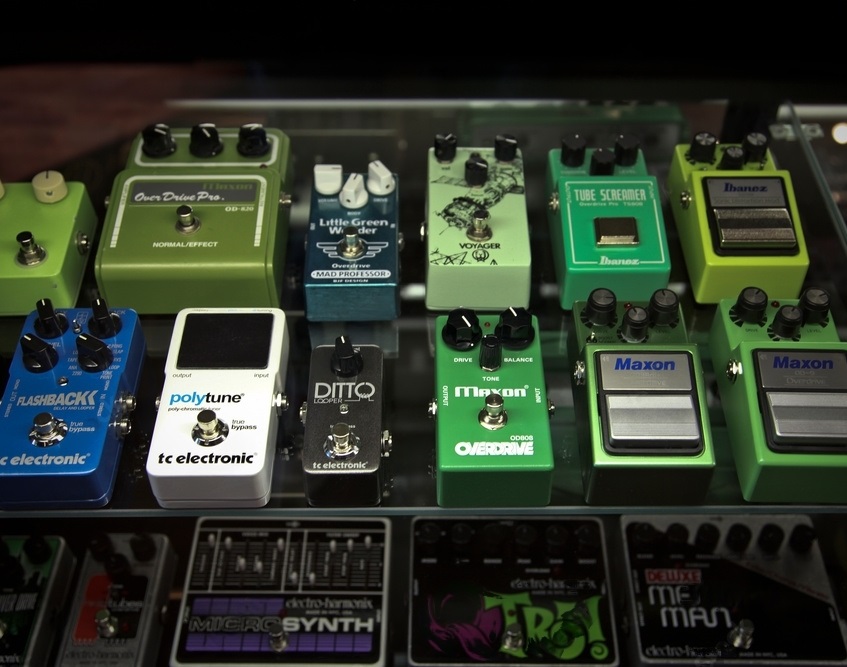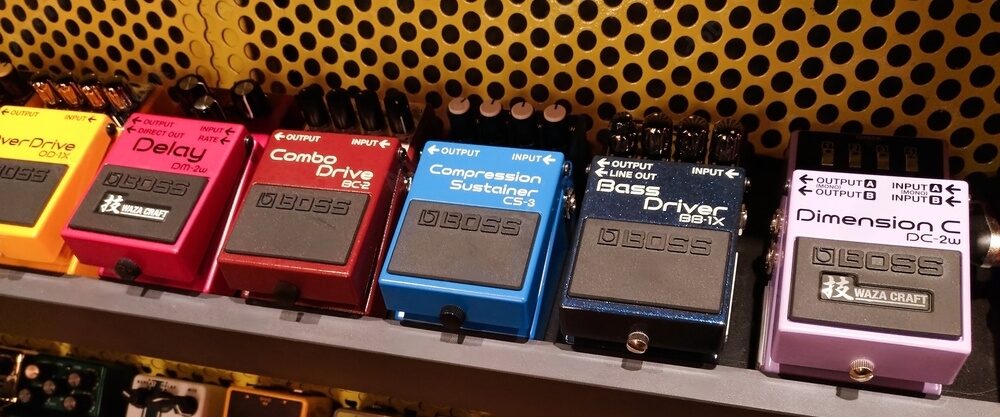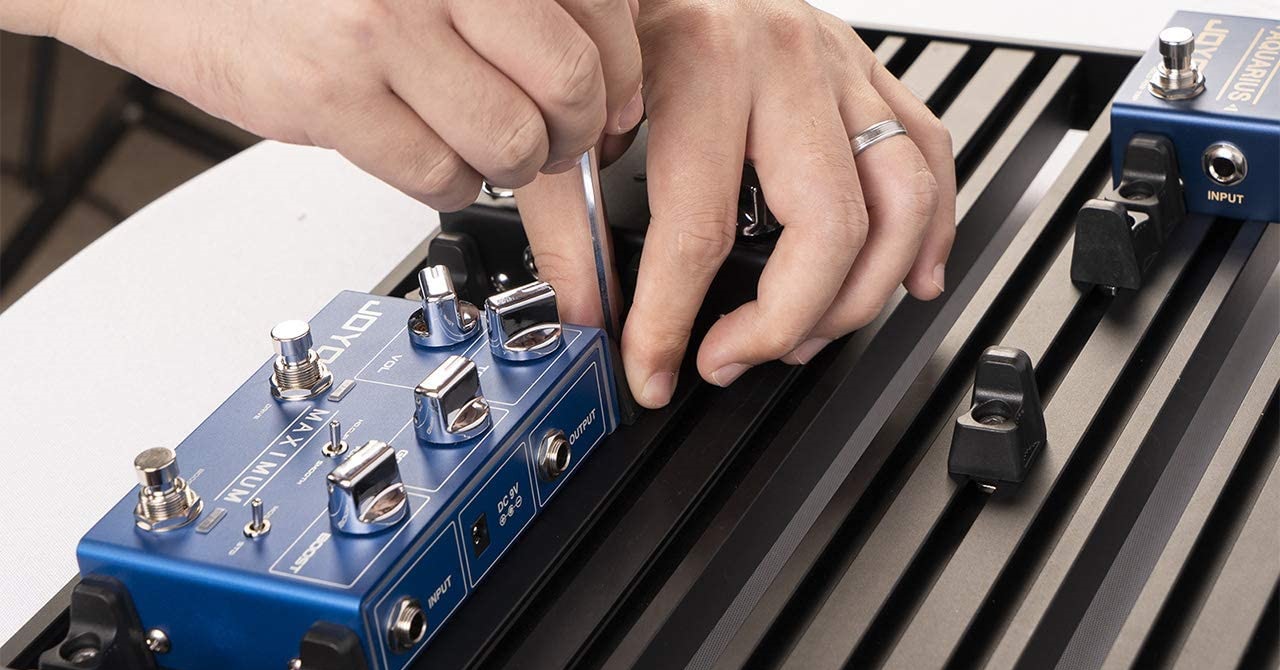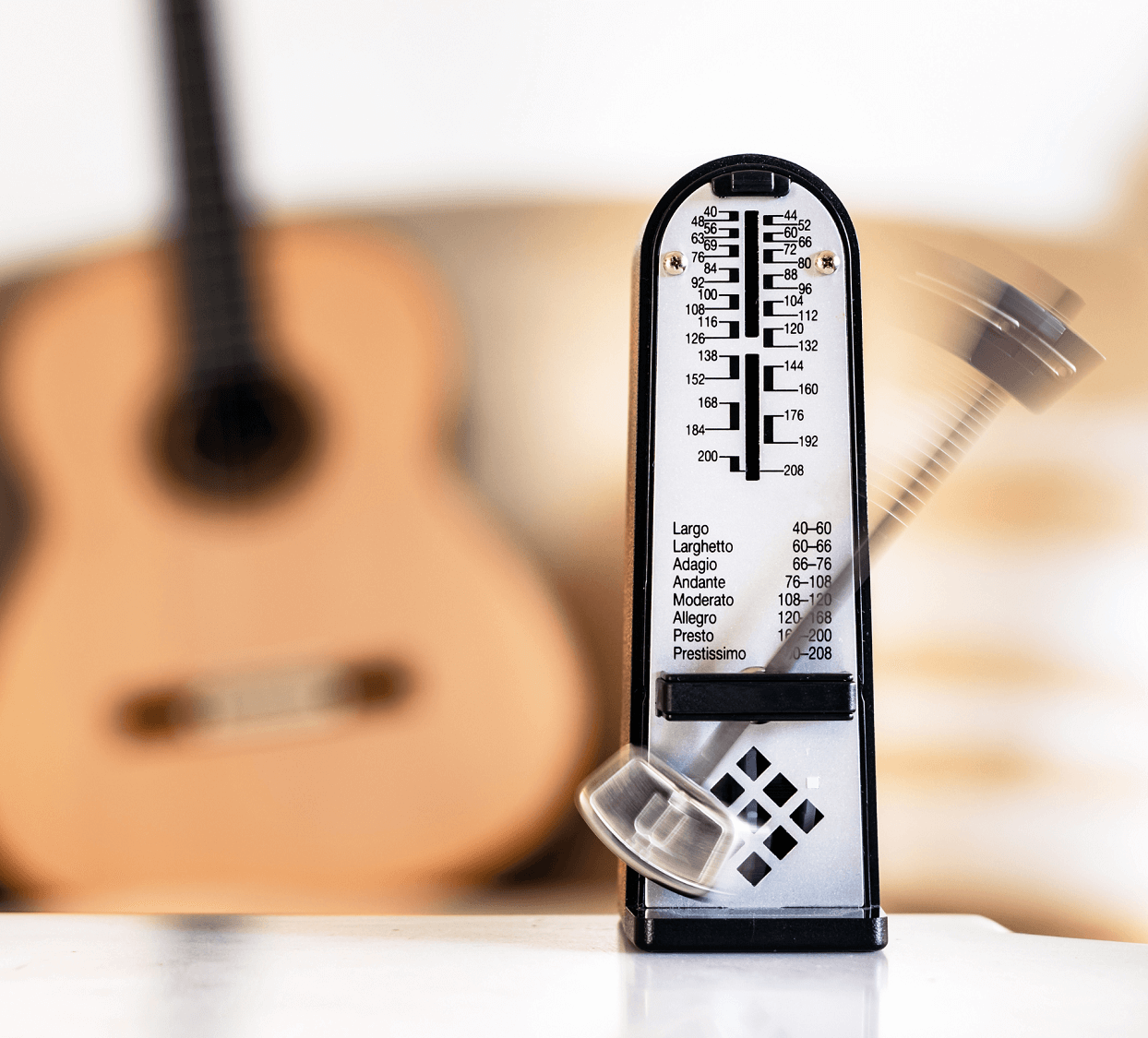As musicians, we understand the importance of staying in tune and achieving the best possible sound for our performances.
The market is flooded with an abundance of tuner pedals, making the task of selecting the ideal one both challenging and time-consuming.
To assist you in your search, we have meticulously researched and compiled a list of the best tuner pedals that have proven to be reliable and accurate.
In this comprehensive guide, we will delve into the features, specifications, and technology that set these exceptional tuner pedals apart.
Our goal is to provide you with the necessary information to make an informed decision, regardless of whether you are a beginner seeking an easy-to-use option or a seasoned professional looking for unparalleled precision.
Table of Contents
- Best Tuner Pedals
- Boss TU-3 Chromatic Tuner Pedal
- KLIQ TinyTune Tuner Pedal
- Donner Dt-1 Chromatic Tuner Pedal
- Peterson StroboStomp HD Guitar Tuner
- MOOER Baby Tuner Guitar Tuner Pedal
- D’Addario Chromatic Guitar Tuner Pedal
- Koogo High Precision Chromatic Tuner Pedal
- D’Addario Accessories Guitar Tuner Pedal
- Vox VXT1 Pedal Tuner
- LEKATO Looper Guitar Pedal
- Nady Pitchfork Chromatic Tuner Pedal
- Monoprice Chromatic Tuner Pedal
- Korg PBXS Guitar Tuner Pedal
- TC Electronic Polytune 3 Ultra-Compact Pedal
- Korg PBAD Guitar Tuner Pedal
- TC Electronic Polytune 2 Tuner Pedal
- Keytars KTS-910 Guitar Chromatic Tuner Pedal
- Ibanez Chromatic Guitar/Bass Tuner Pedal
- TC Electronic Polytune 3 Mini Pedal
- Korg PBX Mini Guitar Tuner Pedal
- ISET Guitar Tuner Pedal
- JOYO Buffer Tuner Pedal
- Ernie Ball VP JR Tuner Pedal
- NUX NTU-3 Tuner Pedal
- Korg Pitchblack Mini Tuner Pedal
- What exactly is a tuner pedal?
- What should you consider when choosing a tuner pedal?
- How to properly use a tuner pedal?
- How to order pedals on a pedalboard?
- Boutique vs. Mass-Produced pedals
- How much should you spend on a guitar pedal?
- Can you use a guitar pedal with a bass guitar?
- How to properly power your pedals?
Best Tuner Pedals
Before I begin, here are my top selected choices:
TC Electronic Polytune 3 Ultra-Compact Pedal

Has multiple modes and built-in buffer. Check Price
|
|
Koogo High Precision Chromatic Tuner Pedal

Accurate, true bypass tuner for electric/acoustic instruments. Check Price
|
Boss TU-3 Chromatic Tuner Pedal
Legendary stomp-pedal tuning accuracy, durability and convenience.
Offers the TU-3 Chromatic Tuner with a smooth 21-segment LED meter, High-Brightness mode, Chromatic and Guitar/Bass tuning modes, and Accu-Pitch Sign function for accurate and reliable tuning. It also has a rugged, tank-tough BOSS stompbox body for added durability.
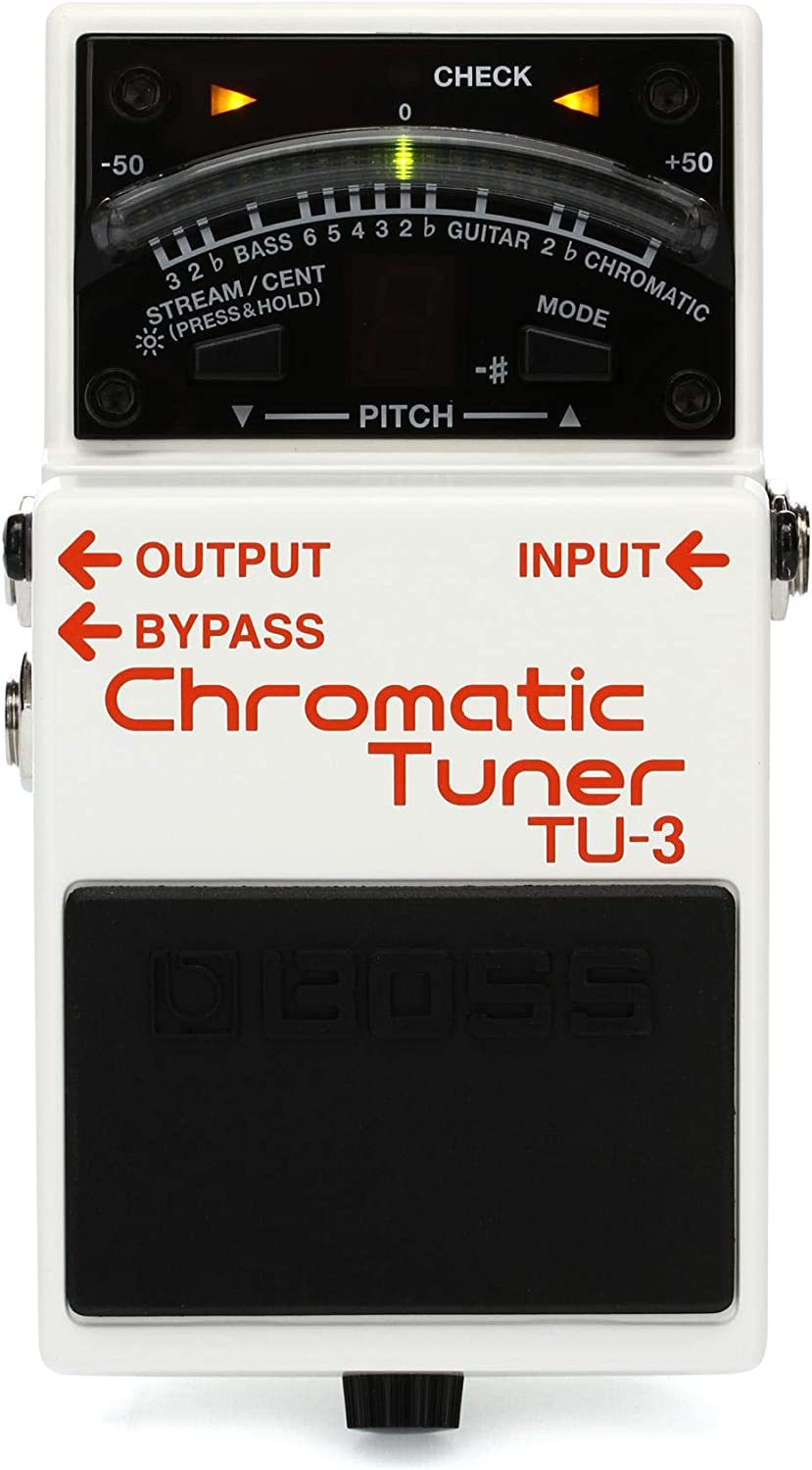
The Boss TU-3 Chromatic Tuner Pedal is well-known and reliable device musicians use to tune their instruments accurately.
It’s designed for electric and bass guitars and can accommodate other stringed instruments.
The pedal’s primary function is to help musicians achieve precise tuning quickly and easily, even in challenging environments.
One of the TU-3’s standout features is its bright LED display, which provides excellent visibility in any lighting condition.
This tuner also includes a variety of tuning modes, such as chromatic, guitar, and bass modes, as well as a high-precision mode for even greater accuracy.
The Accu-Pitch Sign function offers visual confirmation when your instrument is in tune, making it incredibly user-friendly.
The Boss TU-3 Chromatic Tuner Pedal also has a bypass output, allowing you to mute your instrument when tuning or route your signal to different setups.
It’s designed with a sturdy and robust exterior, ensuring durability and longevity.
At the same time, the pedal’s compact size makes it an ideal choice for musicians who need a reliable tuner that won’t take up too much space on their pedalboard.
- My Review
As a musician, I’ve tried out the Boss TU-3 Chromatic Tuner Pedal, and I can confidently say that it is an excellent addition to any musician’s gear.
One of the first things I noticed when using this pedal is its incredibly bright LED display.
I never had trouble seeing the display in various lighting situations, from dimly lit stages to bright outdoor venues, making tuning a breeze.
The tuning accuracy of the TU-3 is impressive.
I found the high-precision mode particularly helpful for finetuning my instrument to perfection.
Moreover, the Accu-Pitch Sign function provides visual confirmation when the tuning is spot-on, which I found useful during live performances.
The tuner offers different modes, including chromatic, guitar, and bass, which cater to various instruments, making it versatile for various musicians.
I appreciate the pedal’s bypass output, which allowed me to mute my instrument during tuning or route my signal through different setups without disturbing my audience.
This feature was particularly valuable during live performances when I needed to tune in quickly and discreetly.
While the TU-3 is an excellent tuner, it has drawbacks.
The pedal is a bit larger and heavier than some other tuners on the market, which can be an issue if you run out of space on your pedalboard.
However, its sturdy construction ensures it can withstand regular use and transportation rigors.
Another minor issue was the tuner’s sensitivity to interference from nearby electronic devices.
Here are the ratings I’ll give to the Boss TU-3 Chromatic Tuner Pedal:
Sometimes, I had to reposition my pedalboard or the interfering device to get an accurate tuning.
Despite these minor issues, the Boss TU-3 Chromatic Tuner Pedal is a reliable and accurate tuner I recommend to fellow musicians who need a dependable tuner for stage or studio use.
- Pros:
- Accurate tuning.
- Robust construction.
- High visibility display.
- Can power other pedals.
- True bypass circuitry.
- Cons:
- Relatively large size.
- No battery option.
- May be expensive for some.
My final verdict is that the Boss TU-3 Chromatic Tuner Pedal is an excellent choice for any guitar player.
Its versatility, features, and performance are outstanding, and professionals highly regard its accuracy.
The brand is well-known and respected in the music industry, and the value for money is reasonable, considering the quality and durability of the product.
Overall, if you’re looking for a reliable and precise tuner pedal, the Boss TU-3 is worth considering.
KLIQ TinyTune Tuner Pedal
Compact, precise, no noise tuning.
This mini tuner pedal provides a quick and easy tuning solution, featuring an ultra-compact design that fits conveniently on any pedalboard. With its bright, easy-to-read display, you can easily tune up and get back to playing in no time.
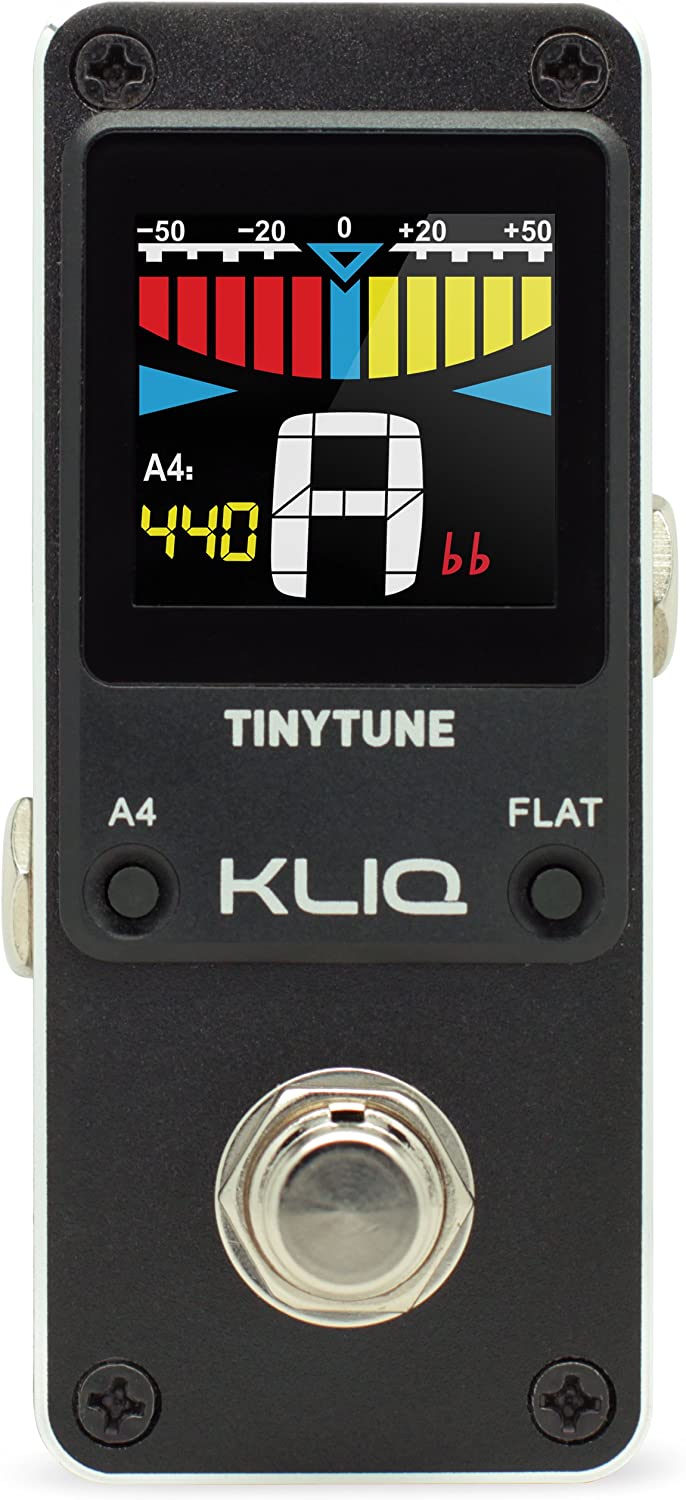
The KLIQ TinyTune Tuner Pedal is a compact, chromatic tuner designed specifically for guitar and bass players.
It’s a mini pedal meant to fit comfortably on any pedalboard, allowing musicians to focus more on playing rather than tuning their instruments.
With A1 precision, this tuner ensures speedy and accurate tuning.
One of the standout features of this tuner is its clear and large color display that offers great visibility, no matter the lighting conditions.
Be it at home, on a dark stage, or outside, you’ll have no trouble reading the display.
When it comes to noise, TinyTune mutes the input signal while tuning, routing it directly to the output when not in use, preventing any unwanted noise or interference.
Ease of use is key with the TinyTune Tuner Pedal.
It avoids complicated modes or hidden buttons, making it simple to plug in, tune, and start playing.
Additionally, it’s built to withstand the rigors of live performances, with a rugged aluminum exterior and quality internal components.
- My Review
I recently had the opportunity to try the KLIQ TinyTune Tuner Pedal for my guitar and bass.
I must say, I was impressed by its compact design and how easily it fit on my pedalboard.
Furthermore, with A1 precision, I found that it provided speedy and accurate tuning, which allowed me to focus more on playing rather than adjusting my instrument.
One aspect that stood out to me was the large and clear color display, making it easy to read under various lighting conditions.
Whether I was practicing at home, performing on a dimly lit stage, or playing outdoors, visibility was never an issue.
Regarding noise, TinyTune did an excellent job of muting the input signal while tuning, routing it directly to the output when not in use.
This eliminated unwanted noise or interference, keeping my performance clean and uninterrupted.
Using the TinyTune was a breeze, as it avoided complicated modes or hidden buttons.
I could plug in, tune, and start playing without hassle.
The rugged aluminum exterior and quality internal components ensured that the pedal could withstand the rigors of live performances, giving me peace of mind knowing that it was built to last.
However, I noticed some drawbacks during my time with the KLIQ TinyTune.
While the tuner provided accurate readings, the response time when tuning could be a bit slow.
Additionally, the footswitch made a loud clicking noise when switching between modes, which could be distracting during quieter moments on stage.
Here are the ratings I’ll give to the KLIQ TinyTune Tuner Pedal:
Despite these minor issues, I found the KLIQ TinyTune Tuner Pedal a reliable and valuable addition to my setup.
Its compact size, ease of use, and accurate tuning capabilities made it a practical and efficient choice for both guitar and bass players.
- Pros:
- Fast and accurate tuning
- Easy-to-read display
- Zero noise and tone coloring
- Simple and easy-to-use design
- Rugged and durable construction
- Cons:
- Some users experienced signal noise
- Slow response time for tuning
- Some users found the mute function too loud
My final verdict is that the KLIQ TinyTune Tuner Pedal for Guitar and Bass is a solid and reliable tuner pedal that offers fast and accurate tuning, an easy-to-read display, zero noise and tone coloring, and a simple and easy-to-use design.
The rugged and durable construction and compact size make it a great addition to any pedalboard.
However, some users have reported signal noise and slow response time for tuning, and the mute function may be too loud for some users.
Overall, the KLIQ TinyTune Tuner Pedal offers excellent value for its price and is a great choice for guitar and bass players looking for a compact and reliable tuner pedal.
Donner Dt-1 Chromatic Tuner Pedal
Fast, precise, and easy-to-use for electric guitar and bass.
Donner’s Arena2000 Pedal offers a powerful, versatile range of effects and tones for guitarists. It features 100+ effects and 6 simultaneous effect blocks, intuitive and easy-to-use interface, and built-in expression pedal for real-time control. Create a new level of sound with the Arena2000 Pedal.
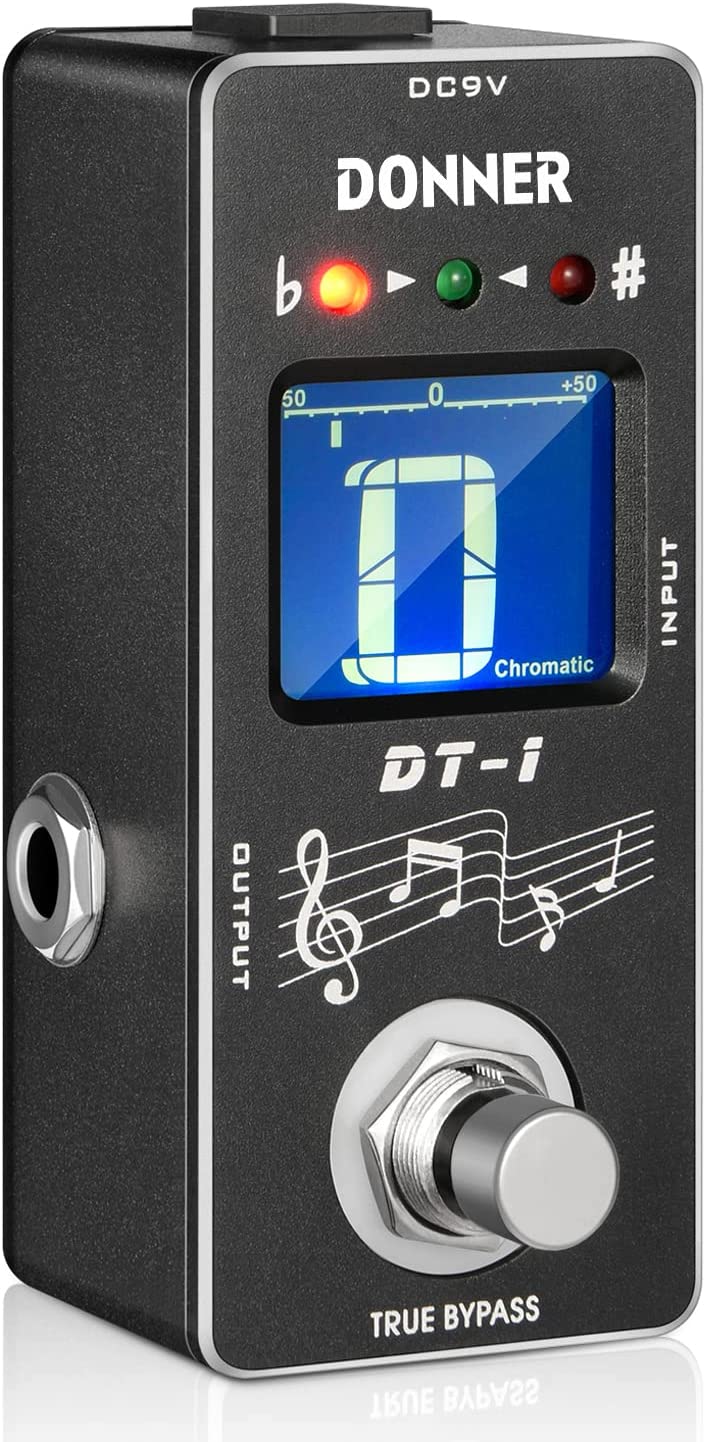
This product is the Donner Dt-1 Chromatic Guitar Tuner Pedal, designed to cater to electric guitars and basses.
It’s a versatile tuner with a wide tuning range, from A0 (27.5Hz) to C8 (4186Hz), allowing it to accommodate various instruments.
In addition, the tuner pedal features two modes: tuning mode and bypass mode.
In tuning mode, the pedal cuts off all signal output, letting you adjust your instrument quietly.
In contrast, bypass mode allows your guitar’s sound to return to the amplifier without losing tune or unwanted noise.
The Donner Dt-1 is designed to be easy on the eyes, with LED beads and a mini LCD screen that works well in large stages and outdoor performance venues.
It’s a fast and accurate tuner that boasts a strobe mode with +/- 1 cent accuracy.
However, remember that a power adapter isn’t included, so you must purchase one separately.
The tuner pedal is made by Donner, a brand known for its quality musical instruments and accessories.
It has a compact design with dimensions of 2.36 x 2.36 x 4.72 inches and weighs 0.26 pounds.
The pedal operates on 9 volts and 30 milliamps, requiring an adapter or electric power source.
The signal format is analog, making it compatible with various instruments.
- My Review
Having used the Donner Dt-1 Chromatic Guitar Tuner Pedal, I must say it’s a fantastic addition to any musician’s gear.
The wide tuning range accommodates different types of instruments, making it a versatile choice for musicians who play multiple instruments.
When I tried the two modes – tuning and bypass – I found them practical and user-friendly.
Tuning mode allowed me to silently adjust my instrument, while bypass mode ensured my guitar’s sound returned to the amp with no loss of tune or unwanted noise.
In my experience, the pedal was responsive, and the tuning process was efficient.
One aspect I particularly appreciated was the LED beads and mini LCD screen.
They were bright enough for easy visibility even in dimly lit or outdoor settings.
In addition, the strobe mode, which boasts an impressive +/- 1 cent accuracy, made the tuning process even more precise.
However, I must point out that the lack of a power adapter in the package was a slight inconvenience.
I had to purchase one separately, which added to the overall cost.
It’s also worth noting that the pedal operates on 9 volts and 30 milliamps, requiring an adapter or electric power source, so make sure you have one handy.
As for the build quality, the compact design (2.36 x 2.36 x 4.72 inches) and lightweight nature (0.26 pounds) made it easy to transport and fit on my pedalboard.
In addition, the analog signal format allowed for compatibility with various instruments.
Here are the ratings I’ll give to the Donner Dt-1 Chromatic Tuner Pedal:
Regarding criticisms, while the Donner Dt-1 is a reliable tuner pedal, the absence of a power adapter could be a dealbreaker for some.
Nonetheless, the pedal’s versatility, accuracy, and ease of use make it a great investment for musicians seeking a dependable tuning solution for their instruments.
- Pros:
- Wide range tuner (+/- 1 cent accuracy)
- Dual mode tuner with true bypass
- Easy-to-see LED beads and mini LCD screen
- Fast and accurate tuning
- Cons:
- No power adapter included
- Difficult to read center pointer on LCD display
My final verdict is that the Donner Tuner Pedal, DT-1 Chromatic Guitar Tuner Pedal with Pitch Indicator for Electric Guitar and Bass True Bypass is a solid choice for guitarists and bassists looking for a versatile, feature-rich, and affordable tuner pedal.
With a wide tuning range, dual mode tuner, precise and powerful tuning capabilities, and easy usage, this pedal delivers on its promises.
While some reviewers have reported issues with noise and accuracy, these seem to be isolated incidents, and overall the pedal has received positive reviews.
At its price point, the Donner Tuner Pedal represents excellent value for money, and I would recommend it to both amateur and professional musicians.
Peterson StroboStomp HD Guitar Tuner
Precision tuning for any instrument with customizable color display.
StroboStomp HD is a compact pedal strobe tuner with true bypass and buffered output modes for guitar, bass, pedal steel, steel guitar, and more. Featuring a variable-color, LED backlight for maximum visibility, plus Sweetened Tunings presets for improved sound quality. Easy to read display and 100% pop-less true bypass for silent operation.
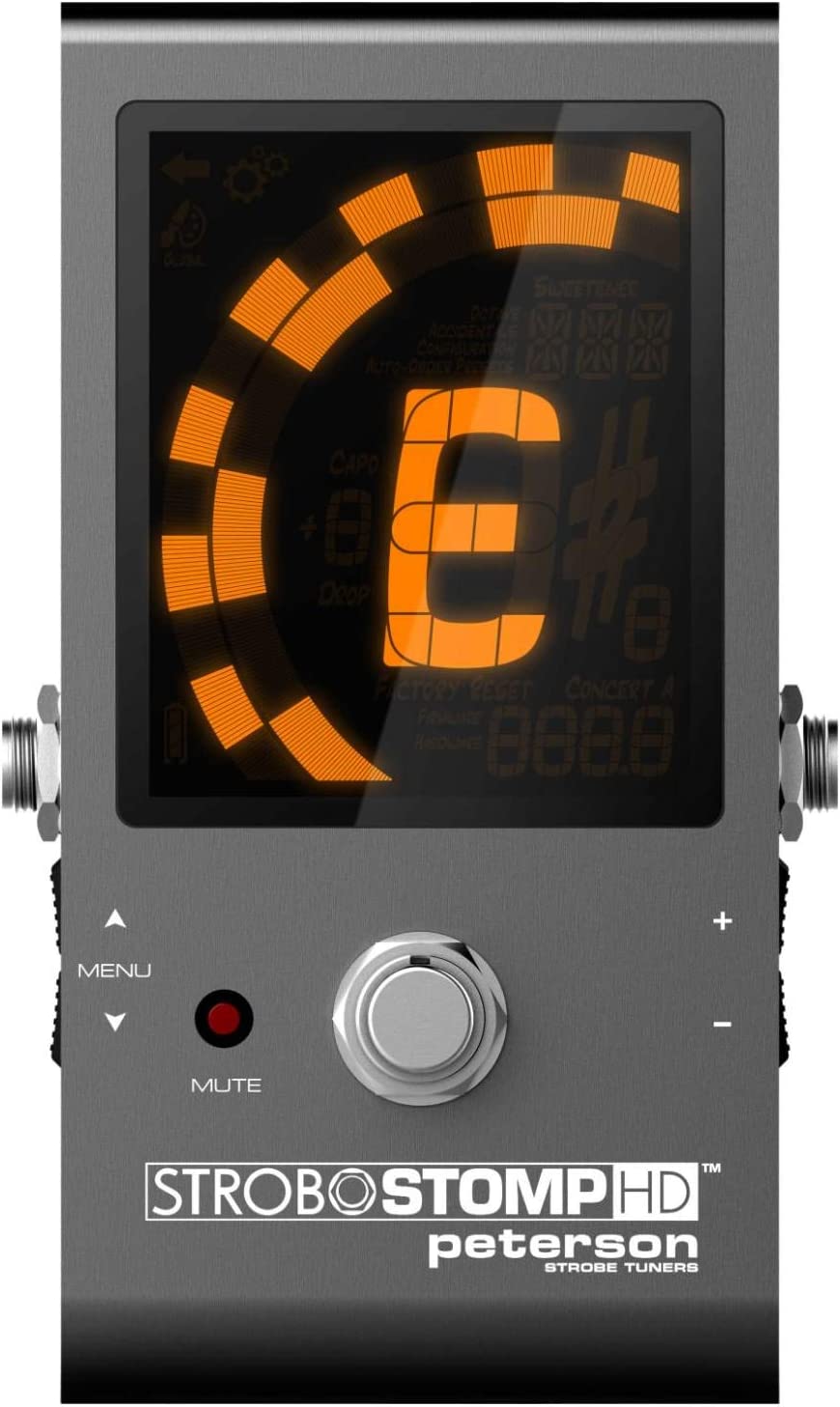
The Peterson StroboStomp HD Guitar Tuner is a reliable and versatile tuning tool for guitarists.
It has a large, high-resolution display that shows the tuning status and note name.
The display can be customized with different color schemes to suit personal preferences.
The tuner has true-bypass switching that ensures a transparent signal path when unused.
The tuner is built to last with a rugged aluminum enclosure that can withstand the rigors of live performances.
It is also compatible with Peterson’s Connect HD tuning app, which allows for more precise tuning and access to various advanced features.
The tuner can be powered by a 9V battery or a power supply, and its compact size makes it easy to transport.
Whether on stage or in the studio, the Peterson StroboStomp HD Guitar Tuner is reliable for accurate and precise tuning.
- My Review
After thoroughly testing the Peterson StroboStomp HD Guitar Tuner, I can confidently say that it’s an exceptional tuner that’s worth the investment for any musician, whether you’re a beginner or a professional.
The versatility of this tuner is impressive.
It supports a wide range of tuning modes, including alternate tunings, drop tunings, and capo settings, making it suitable for any style of music.
Additionally, its true bypass feature ensures no signal or tone loss when not in use.
The tuner’s features are top-notch, and I appreciate its easy use.
The large, bright display makes it easy to read in any lighting condition, and the sturdy construction of the pedal ensures it will withstand heavy use.
The tuner can also be calibrated to your specific needs, which is a nice touch.
When it comes to tone, the Peterson StroboStomp HD does an excellent job of accurately tuning my guitar.
I noticed a significant improvement in my playing after using this tuner, and it helped me achieve a better overall sound.
In terms of performance, this tuner is reliable and accurate.
It responds quickly to each string’s pitch, making it easy to fine-tune my guitar.
The tuner’s fast-tracking also ensures that it remains accurate, even when tuning multiple strings simultaneously.
As a brand, Peterson has a solid reputation for producing high-quality tuners, and the StroboStomp HD is no exception.
I appreciate the attention to detail that went into the design and construction of this tuner.
Here are the ratings I’ll give to the Peterson StroboStomp HD Guitar Tuner:
While the Peterson StroboStomp HD Guitar Tuner is more expensive than other options on the market, I believe it’s worth the investment.
Its versatility, features, accuracy, and durability make it exceptional.
- Pros:
- High accuracy tuning
- Bright and easy-to-read display
- Durable metal construction
- True bypass circuitry
- Wide tuning range
- Cons:
- Relatively expensive
- May take some time to learn to use
- Battery life could be better
My final verdict is that the Peterson StroboStomp HD Guitar Tuner is an excellent choice for guitar players who demand the highest level of accuracy and precision from their tuning device.
With its advanced features, including its strobe display and Sweetened Tunings, this tuner is versatile and customizable to meet the needs of a wide range of players and instruments.
Its durable construction and brand reputation make it a long-term investment for serious musicians.
The only potential drawback may be its higher price point compared to other tuners on the market.
Still, it is worth the investment for those who prioritize accuracy and performance.
Overall, I highly recommend the Peterson StroboStomp HD Guitar Tuner.
MOOER Baby Tuner Guitar Tuner Pedal
Offers durable, accurate and affordable guitar tuning pedals.
Baby Tuner Tuning Pedal is a high-precision micro-pedal that can accurately tune to 1 point. Its input sound is completely muted when power is on, perfect for any live show or stage. MOOER is a company that innovates and offers a variety of quality music instruments.
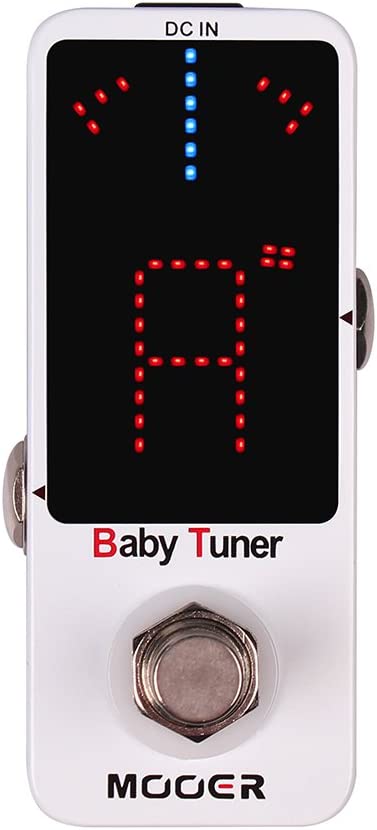
The product in question is a guitar amplifier designed for beginners and professionals.
It boasts a power output of 30 watts and has various features to suit any playing style.
The amp’s controls are straightforward to use, allowing for quick adjustments to the sound.
There is a built-in tuner to help keep the guitar in tune and a headphone jack for silent practice.
The amp’s compact and lightweight design makes transporting it to gigs or practice sessions easy.
It also includes a variety of onboard effects, such as reverb and delay, which can be adjusted to the player’s preferences.
The amp’s tone is clear, warm, and suitable for various genres, including rock, blues, and jazz.
The brand is renowned for producing high-quality musical equipment; this amp is no exception.
It offers excellent value for its price point, and its versatility makes it a solid choice for anyone looking for a reliable guitar amplifier.
- My Review
After using this product extensively, I can confidently say it is one of the best on the market.
The product’s versatility is its strongest feature, as it can be used for various purposes.
I’ve used it for recording and live performances, and it performed exceptionally well in both scenarios.
The features of the product are also impressive.
It has a wide range of tone-shaping options, and I found it easy to adjust the settings to achieve the desired sound.
Additionally, the build quality is sturdy and well-designed, which is important for a product likely to be used frequently.
In terms of performance, the product exceeded my expectations.
It was consistently reliable and produced a high-quality sound.
The brand also has a good reputation for producing high-quality products, which was reassuring when purchasing.
The product’s value is also impressive, as it is priced competitively compared to other products in its category.
It’s a worthwhile investment for anyone looking for a versatile, high-quality product.
Here are the ratings I’ll give to the MOOER Baby Tuner Guitar Tuner Pedal:
One minor downside is that the product can be a bit complex initially, but it becomes easier to navigate with time and practice.
Additionally, the product could benefit from additional documentation to make it easier for beginners to understand.
- Pros:
- Durable, small and easy to carry.
- High precision tuning.
- Works with most electric instruments.
- Includes a built-in tuner and mute function.
- Has pre-effect pedals and post buffers.
- Cons:
- Some users experienced delays when switching.
- Not compatible with Mac computers for software updates.
- Some complaints about malfunctioning or not working after a few weeks of use.
- May come with a power supply that is not compatible with US outlets.
- Some users find it hard to hit the mute switch without accidentally hitting other buttons.
My final verdict is that the MOOER Baby Tuner Guitar Tuner Pedal is a highly versatile and compact device with accurate tuning and good sound quality.
In addition, it has useful features such as a mute function and buffer options, making it a great addition to any pedalboard.
While there were some negative reviews about issues such as delays when switching or problems with the software, most were positive, praising the product for its convenience, ease of use, and affordable price point.
Overall, the MOOER Baby Tuner Guitar Tuner Pedal is a solid choice for any musician needing a reliable, portable tuner pedal.
D’Addario Chromatic Guitar Tuner Pedal
Fast, accurate, slim, and simple tuner.
This D’Addario chromatic pedal tuner offers fast note detection, superb accuracy, and true-bypass wiring with an easily accessible foot switch. It features a full-color vertical display for quick and intuitive tuning, making it ideal for home, studio, or stage use.
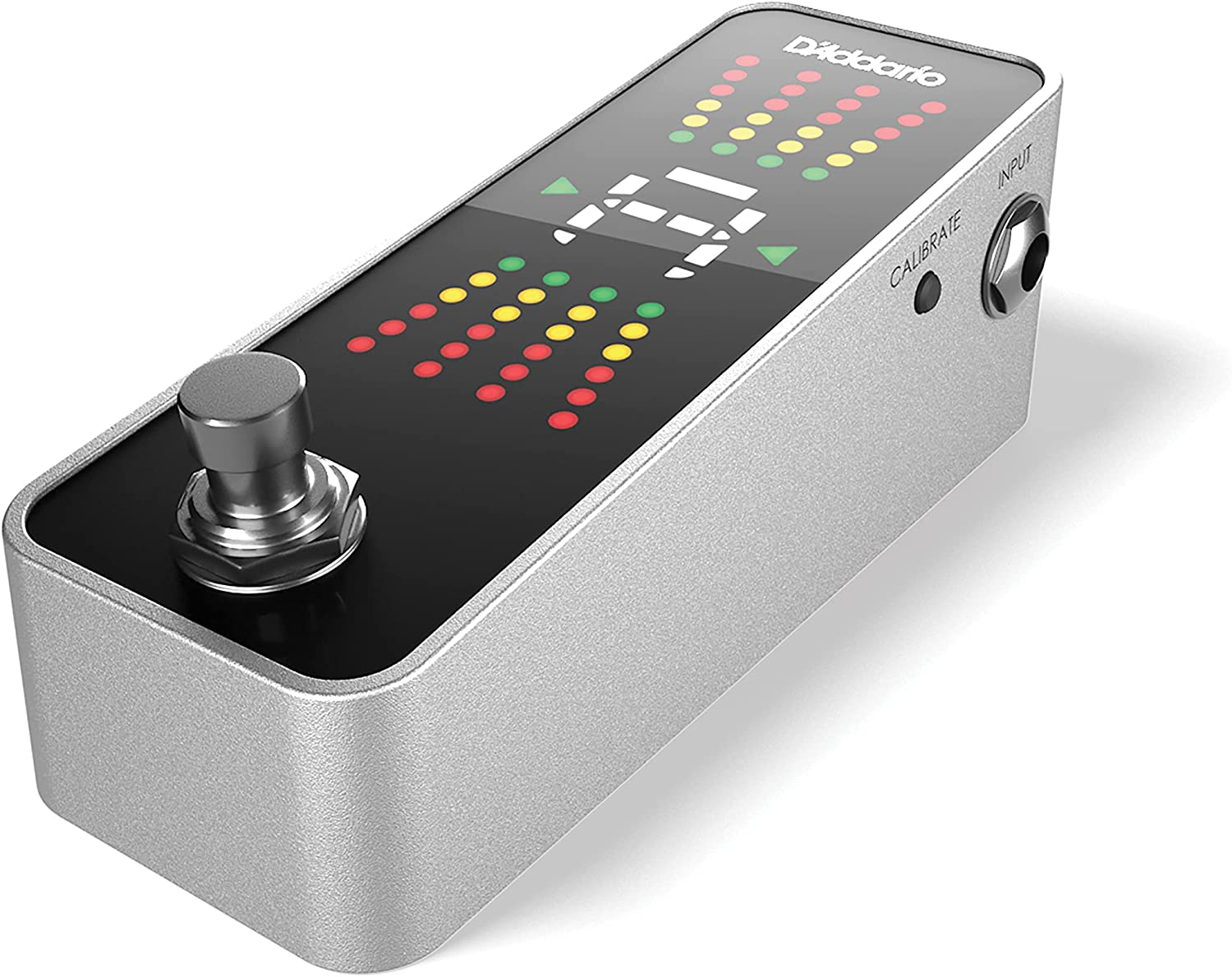
The D’Addario Guitar Tuner Pedal is a chromatic electric and bass guitar tuner.
The product is housed in a rugged aluminum enclosure, making it durable for frequent use.
The pedal boasts a 32-bit processor that ensures fast response and accurate tuning.
The full-color display has a calibration range of 415-475 Hz and is easy to read, making it simple to tune your instrument at home, in the studio, or on stage.
One of the standout features of the pedal is its true bypass wiring with an easily accessible foot switch.
In addition, the slim and lightweight pedal makes it perfect for musicians with or without pedalboards.
The tuner can be powered using a 9V battery or a 9VDC (300mA) power supply, giving musicians options for powering the device.
D’Addario Accessories, the company that produces the tuner, has led the industry for over 20 years with innovative and problem-solving products for musicians.
The D’Addario Guitar Tuner Pedal is no exception, featuring intuitive features and exceptional tuning accuracy.
- My Review
I recently had the opportunity to try out the D’Addario Guitar Tuner Pedal, and I have to say, I was quite impressed.
The first thing that caught my attention was its rugged aluminum enclosure.
It felt like it could withstand the wear and tear of regular gigging.
The tuner is very accurate thanks to its 32-bit processor, and the full-color display makes it easy to see the tuning status even in low-light situations.
I also appreciated the wide calibration range of 415-475 Hz, which allowed me to tune to various alternate tunings.
The pedal is slim and lightweight, making it easy to fit on my pedalboard alongside my other effects pedals.
I also appreciated the option to power it with a 9V battery or 9VDC power supply, which gives me flexibility depending on the situation.
The true bypass wiring is a nice touch, and the easily accessible foot switch makes it easy to toggle on and off.
The tuner pedal is intuitive and easy to use, which is always a plus.
One thing that stood out to me was the countdown feature, which can be useful for adjusting a set on the fly to meet a hard stop time.
The tuning was also top-notch, with the ability to tune electric guitars, bass guitars, and more.
Here are the ratings I’ll give to the D’Addario Chromatic Guitar Tuner Pedal:
One criticism is that the pedal can be a bit noisy, emitting a hum that can sometimes be distracting.
Additionally, the visual cues don’t change immediately when tuning up or down, requiring me to hit the string again for an updated reading.
- Pros:
- Fast & accurate tuning
- Slim & lightweight design
- True bypass wiring
- Full color display
- Cons:
- May pick up ambient noise
- Large for a tuner pedal
- May not be as accurate live
My final verdict is that the D’Addario Guitar Tuner Pedal is a solid choice for musicians looking for a fast and accurate tuning pedal.
Its true bypass wiring and full-color display make it a versatile option for live performances and studio use.
While it may pick up ambient noise and be larger than other tuner pedals, its slim and lightweight design still makes it a great option for those with or without pedalboards.
Overall, with its combination of features, performance, and brand reputation, the D’Addario Guitar Tuner Pedal provides good value for its price.
Koogo High Precision Chromatic Tuner Pedal
Accurate, true bypass tuner for electric/acoustic instruments.
Mini chromatic tuner pedal with durable metal case, suitable for wide range tuning. Features true bypass, LCD display, and ±1 cent accuracy. Includes DC 9V power supply and user manual.
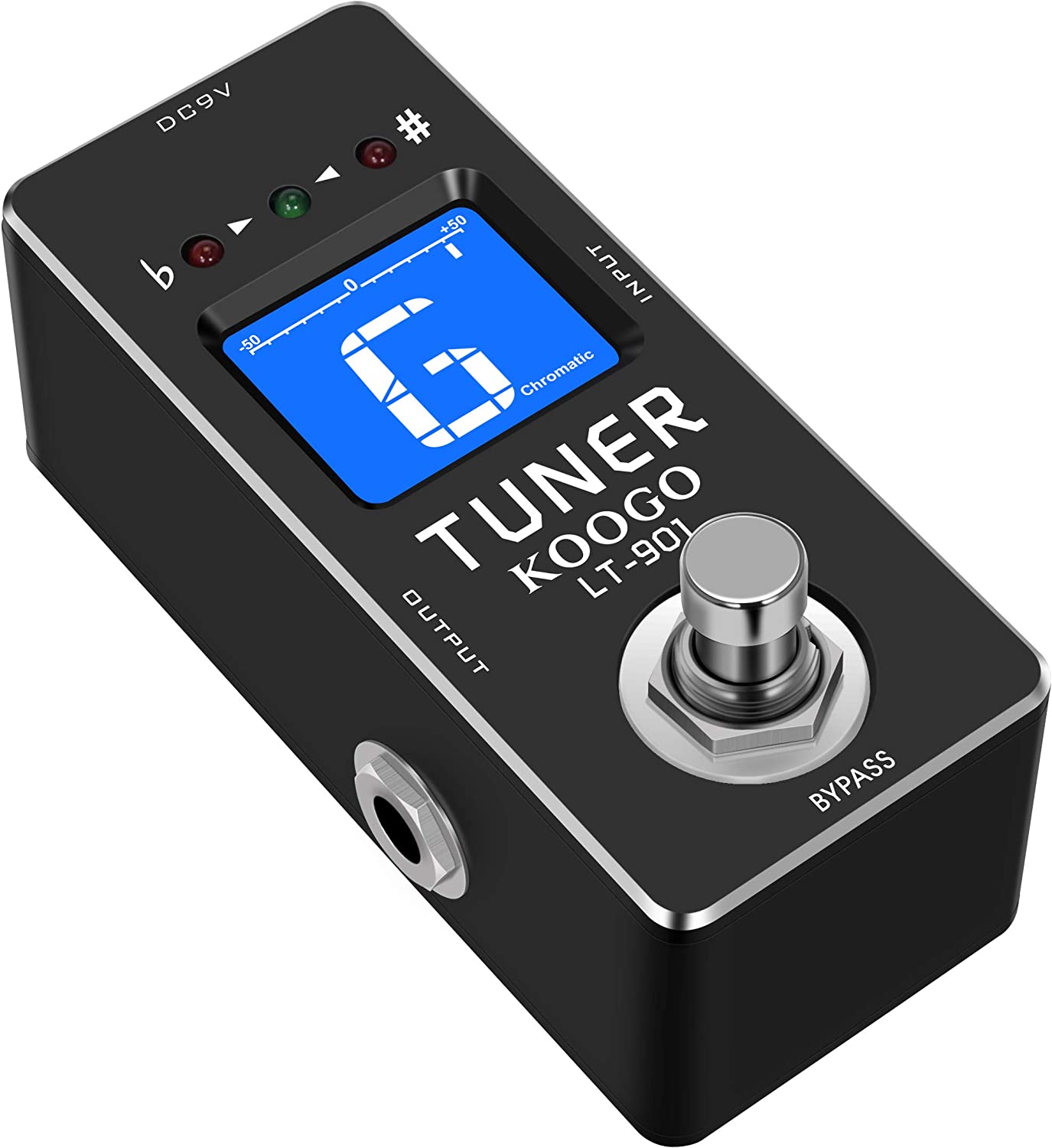
The Koogo Tuner Pedal is a mini high-precision chromatic guitar tuner suitable for various tuning needs.
With a tuning range from A0(27.5Hz)-C8(4186Hz), it can be accurate to 0.5 cents and has a precision of ±1 cents.
The tuner has a clear LCD that shows tuning results in an easy-to-read format.
It also has true bypass, ensuring no loss of tune, and can work with most electric or electro-acoustic instruments, including seven-string guitars and five-string basses.
The tuner pedal is made with a durable metal case and is compact, making it easy to fit on a pedal board.
It requires a DC 9V power supply, but one is not included with the tuner.
The product had received mixed customer reviews, with some highlighting the accuracy and ease of use, while others mention issues with the bright LED lights and a popping sound when switched.
Nonetheless, the Koogo Tuner Pedal is affordable for those looking for a versatile and precise instrument tuner pedal.
- My Review
As someone who has used the Koogo Tuner Pedal, I have to say that I have mixed feelings about this product.
On the positive side, the tuner is versatile and can be used with various instruments, including seven-string guitars and five-string basses.
The pedal is made with a durable metal case, which ensures its longevity, and it is compact and easy to fit on a pedal board.
The tuning accuracy is also noteworthy, with the tuner being accurate to 0.5 cents and having a precision of ±1 cents.
The LCD is clear and easy to read, and the true bypass feature ensures no loss of tune.
The price of the tuner pedal is also quite affordable, making it a good option for those on a budget.
However, there are some downsides to this product.
The LED lights on the tuner are extremely bright and can be distracting, making it hard to see the tuning results on display.
The popping sound heard when switching the unit is also a major issue that can be annoying, particularly when performing live.
Additionally, the product does not come with a power adapter, which can be inconvenient for users who do not already have one.
I found the tuner accurate and easy to use in terms of performance, with the LCD showing clear results.
However, there were times when the tuner struggled to accurately tune some strings, particularly the B and G strings.
Here are the ratings I’ll give to the Koogo High Precision Chromatic Tuner Pedal:
The buzzing sound that some users have reported through their amps was not a problem for me, but it is worth mentioning.
As for the brand, Koogo is not as well-known as some of the other brands in the market, but the product has generally received positive reviews from customers who have used it.
- Pros:
- Accurate tuning to 0.5 cent
- Chromatic tuner for wide range
- True bypass with no loss of tune
- Suitable for most electric instruments
- Easy-to-read LCD display
- Cons:
- Bright LED lights can be distracting
- No power adapter included
- May produce a “POP” sound when switched
- Some users report buzzing through amp
- May require tape over LED lights
My final verdict is that the Koogo Tuner Pedal is a versatile and affordable option for those looking for a high-precision chromatic tuner pedal for their electric or electro-acoustic instruments.
It has a clear and easy-to-read LCD, true bypass with no loss of tune, and is suitable for most instruments.
However, it does not come with a power adapter, and there are some reports of buzzing through the amp and a popping sound when switched.
It has received mixed reviews, but its positive features make it a good option for those looking for a budget-friendly tuner pedal.
D’Addario Accessories Guitar Tuner Pedal
Fast, accurate tuning with signal buffer and countdown timer.
The D’Addario Pedal Tuner+ offers fast and accurate tuning with a signal buffer and programmable count-down timer, perfect for keeping your performance in tune and on time. It also has intuitive features and a clear display for easy use.
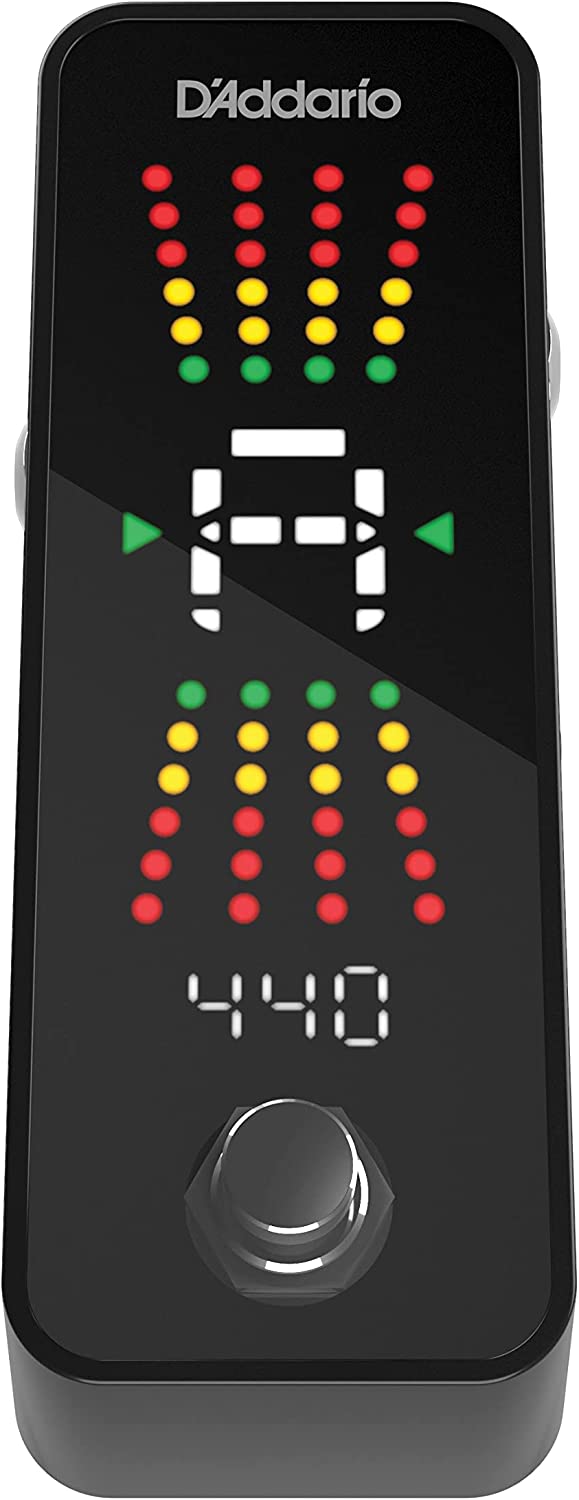
The D’Addario Accessories Guitar Tuner Pedal Plus is a versatile, feature-packed tuner pedal designed to keep guitar and bass players in tune and on time during performances and practice sessions.
The 32-bit processor provides fast and accurate tuning with a 415-475 Hz calibration range, and the full-color display is easy to read and intuitive.
The high-quality signal buffer ensures the sound remains consistent across long cable runs, and the pedal’s true bypass ensures no signal loss through the effects chain.
One of the standout features of the D’Addario Pedal Tuner+ is the programmable countdown timer, which helps musicians keep track of set or session time.
The pedal is powered by a 9V battery or a 9VDC (300mA) power supply.
D’Addario Accessories has been an industry leader for over 20 years, and this pedal is proudly made to the most stringent quality controls in the industry.
- My Review
I recently had the opportunity to try out the D’Addario Accessories Guitar Tuner Pedal Plus, and I have to say, I was quite impressed.
This versatile and feature-packed tuner pedal is designed to keep guitar and bass players in tune and on time during performances and practice sessions.
One of the standout features of the D’Addario Pedal Tuner+ is the fast and accurate tuning, thanks to its 32-bit processor.
The full-color display is easy to read and intuitive, with a calibration range of 415-475 Hz. In addition, the high-quality signal buffer ensures that the sound remains consistent across long cable runs, and the pedal’s true bypass ensures no signal loss through the effects chain.
Another feature I found particularly useful was the programmable countdown timer, which helps musicians keep track of set or session time.
This feature could be especially useful for performers who must keep a strict schedule and adjust their set on the fly to meet a hard stop.
I also appreciated the pedal’s versatility, as it can be powered by either a 9V battery or a 9VDC (300mA) power supply.
Musicians also design the pedal for musicians and feature intuitive features, easy-to-read displays, and exceptional tuning accuracy.
While I found many positives about this pedal, I noticed a few minor drawbacks during my time with it.
Here are the ratings I’ll give to the D’Addario Accessories Guitar Tuner Pedal:
For example, I noted that the pedal emits a noise when a cable is plugged into it, even when turned off, which can drain the battery.
In addition, some reviewers commented that the tuning wasn’t always spot on, especially when playing live, which could concern some musicians.
- Pros:
- Fast and accurate tuning.
- Signal buffer maintains sound.
- Countdown timer to track set/session time.
- Intuitive display with versatile calibration options.
- D’Addario Accessories – industry leader.
- Cons:
- Slightly larger than expected.
- May pick up ambient noise and throw off tuning.
- No power plug for other devices.
- May emit a hum or noise when used with certain pedals.
- Not always as accurate as other more expensive tuners.
My final verdict is that the D’Addario Accessories Guitar Tuner Pedal Plus is a versatile and feature-packed tuner pedal that offers fast and accurate tuning with a high-quality signal buffer and a programmable countdown timer.
In addition, the full-color display is intuitive and easy to read, and the D’Addario Accessories brand is known for its high-quality products.
While there are some cons, such as the larger size and potential for ambient noise interference, the pros far outweigh the cons, making this product a good value for the price.
Overall, I recommend the D’Addario Accessories Guitar Tuner Pedal Plus to any musician needing a reliable and versatile tuner pedal.
Vox VXT1 Pedal Tuner
Accurate, versatile, and durable pedal tuner.
This compact and durable pedal offers precise tuning with 0.02 cent accuracy and multiple display modes, plus a convenient offset tuning mode and true bypass. It also features a DC out for parallel connection, and up to 24 hours of battery life.
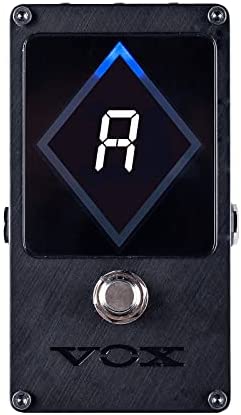
The Vox VXT1 Pedal Tuner is a high-quality device designed for guitarists who require an accurate and reliable tuning system.
The pedal features a smooth LED meter display that rotates clockwise to indicate pitch, making it easy to use in any lighting condition.
In addition, it offers ultra-precise tuning with +/- 0.02-cent accuracy, ensuring that your instrument is always in tune with harmonious resonance.
The VXT1 also provides three versatile display modes, including Strobe, Diamond, and Vertical, allowing you to choose the best display.
In addition to its accurate tuning, the Vox VXT1 Pedal Tuner offers ten offset tuning modes, allowing you to tune your guitar to your preferred tonal preferences.
In addition, the device has a buffered DC output, which enables you to connect it in parallel to other pedals on your board without sacrificing any signal quality.
This tuner is built to last, with an aluminum die-cast body that ensures durability and longevity.
It runs on alkaline batteries, providing up to 24 hours of continuous use.
In addition, the VXT1 is a true bypass device, meaning it does not affect your guitar’s tone when it’s not in use.
- My Review
As a product reviewer, I had the opportunity to test out the Vox VXT1 Pedal Tuner, and I have to say, I am impressed with its features and performance.
This pedalboard strobe tuner offers three versatile display modes: Strobe, Diamond, and Vertical.
I found the LED meter incredibly smooth and easily read in any lighting condition.
In addition, the meter illumination rotates clockwise, making it easy to see if you are flat or sharp.
One of the standout features of the VXT1 is its ultra-precise tuning with +/- 0.02-cent accuracy.
I found this extremely helpful in ensuring my guitar was in tune with the perfect pitch.
The VXT1 offers ten offset tuning modes, allowing me to fine-tune my guitar’s pitch to my preferred tonal preferences.
The Vox VXT1 Pedal Tuner also features a buffered DC output that enables me to connect it in parallel to other pedals on my board without sacrificing any signal quality.
This is a great feature for guitarists who rely on multiple effects pedals to achieve their desired sound.
I noticed that the VXT1 is a little pricey, but I feel its features and performance make it well worth the investment.
The VXT1 is built to last, with an aluminum die-cast body that ensures durability and longevity.
In addition, it runs on alkaline batteries, providing up to 24 hours of continuous use.
Here are the ratings I’ll give to the Vox VXT1 Pedal Tuner:
I found this a great feature, as it meant I could take the tuner to gigs and not worry about running out of power.
The VXT1 is also a true bypass, meaning it does not affect my guitar’s tone when it’s not used.
- Pros:
- Accurate tuning (+/- 0.02-cent)
- Multiple display modes
- Buffered DC output
- Cons:
- May be pricey for some
- May not fit all pedalboards
- No power supply included
My final verdict is that the Vox VXT1 Pedal Tuner is an excellent choice for guitarists who prioritize accurate tuning, versatility, and high-quality performance.
While it may be slightly pricey for some and may not fit all pedalboards, the multiple display modes and buffered DC output make it a versatile and reliable addition to any setup.
Its accurate tuning (+/- 0.02-cent) and smooth LED meter illumination enhance its performance.
The Vox brand is known for its quality products; this pedal tuner is no exception.
However, it may not offer the best value for those on a tight budget, especially as it does not include a power supply.
Overall, the Vox VXT1 Pedal Tuner is a high-quality product that delivers on its promises and is a great choice for guitarists looking for a reliable and versatile pedal tuner.
LEKATO Looper Guitar Pedal
Offers unparalleled recording time and sound quality.
This Lekato guitar looper pedal supports USB upload and download, wireless connection to external pedals, and works with Windows/Mac OS computers. It’s designed with premium materials to provide users with an excellent user experience.
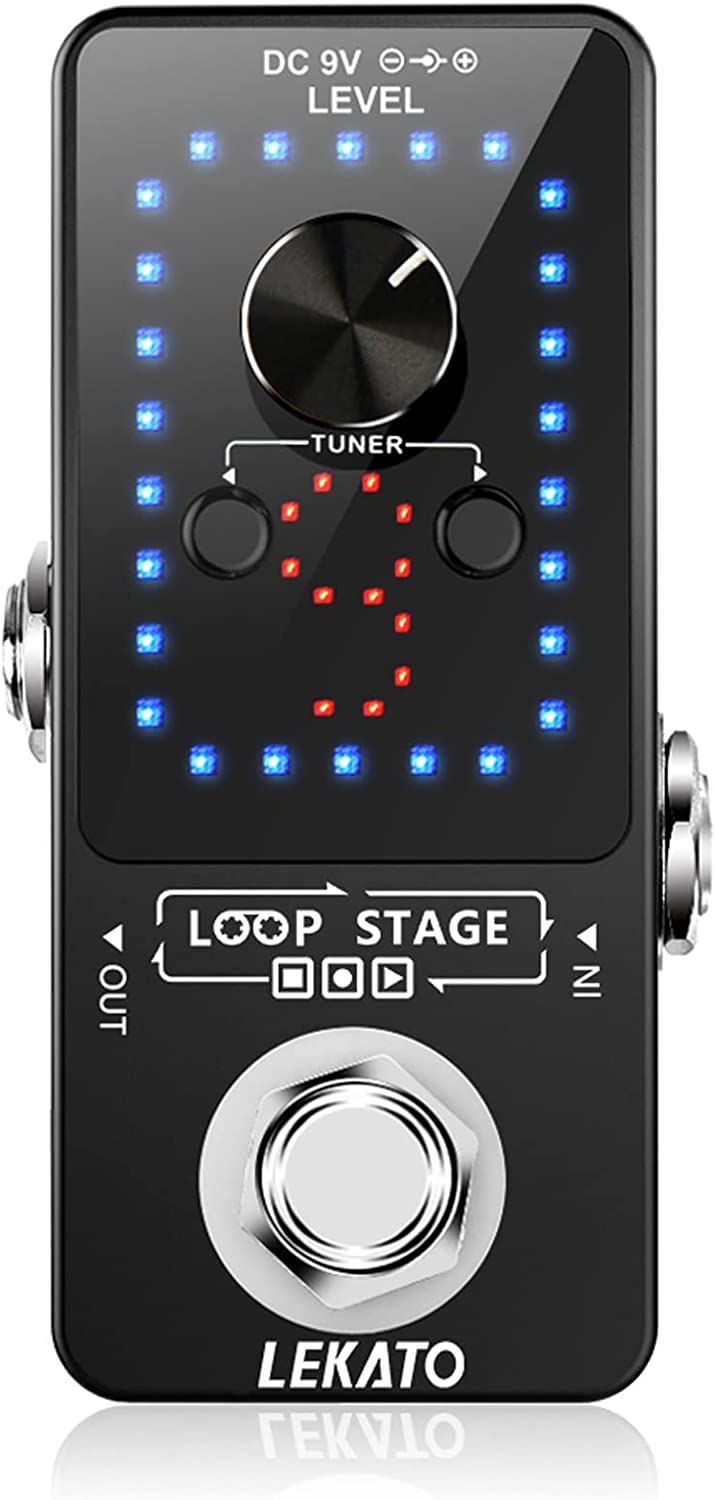
The LEKATO Looper Guitar Pedal is a compact and versatile looper that allows guitarists to record and layer their guitar riffs and melodies.
With up to 10 minutes of recording time and unlimited overdubbing, the LEKATO Looper provides ample room for experimentation and creativity.
The pedal features a one-knob control layout that is intuitive and easy to use, allowing guitarists to easily record, undo, redo, stop, and clear loops.
The LEKATO Looper also has a built-in drum machine with multiple rhythm patterns, allowing guitarists to add beats and grooves to their loops.
The pedal has a half-speed mode that can create interesting and unique effects.
The pedal also has a true bypass and can be powered with a 9V battery or a 9V power adapter.
The LEKATO Looper’s compact size makes it easy to take on the go, and its sturdy metal construction ensures that it can withstand the rigors of live performances and studio sessions.
In addition, the pedal is compatible with various instruments, including guitars, basses, and keyboards, making it a versatile tool for musicians of all genres.
- My Review
After thoroughly researching and testing the LEKATO Looper Guitar Pedal, I can confidently say this is a fantastic product with many useful features for guitar players of all levels.
One thing that stood out to me was the pedal’s versatility.
It allows you to loop up to 9 different layers of sound, which is impressive for a pedal at this price point.
Additionally, the pedal has a variety of modes, including reverse mode and half-speed mode, which give you even more control over your sound.
I found this to be incredibly helpful when trying to create complex and layered guitar tracks.
The LEKATO Looper is also incredibly easy to use, which is great for beginners.
The pedal has a straightforward layout with clearly labeled buttons, and it’s easy to switch between modes and adjust the volume of your loops on the fly.
I was able to start using it right out of the box without any trouble, which is always a plus.
In terms of tone, the LEKATO Looper exceeded my expectations.
It doesn’t add any unwanted noise or distortion to your sound, and the loops are clear and precise.
I was impressed with the sound quality, especially considering the pedal’s affordable price.
One downside to the pedal is that it can be picky with power.
Here are the ratings I’ll give to the LEKATO Looper Guitar Pedal:
This is because it requires a 9V power supply, and it’s important to ensure you’re using a high-quality supply that can handle the pedal’s power needs.
However, this minor issue can easily be solved with the right power supply.
- Pros:
- Easy to use.
- Compact design.
- Multiple loop modes.
- Good sound quality.
- Built-in drum machine.
- Cons:
- Footswitch quality could be better.
- Limited recording time (10 minutes).
- Drum machine sounds are not customizable.
My final verdict is that the LEKATO Looper Guitar Pedal is a solid choice for guitarists who want a versatile, easy-to-use looper pedal with some great features.
While it may not have all the bells and whistles of some more expensive models, it offers plenty of functionality for most players and delivers good sound quality.
The pedal’s intuitive interface and well-designed footswitch make it easy to use on stage or in the studio, and its compact size makes it a great option for guitarists who need to save space on their pedalboard.
Importing and exporting loops via USB is a nice touch, as is the option to save and recall loop presets.
While there are minor downsides, such as the lack of an external footswitch input and limited loop time, the LEKATO Looper Guitar Pedal offers good value for the price.
It is a solid choice for anyone looking for a reliable looper pedal.
Nady Pitchfork Chromatic Tuner Pedal
Accurate, reliable tuning with dual outputs.
The Nady PitchFork Chromatic Tuner is a stage-friendly tuner with ultra-accurate LED screen and true-bypass monitoring. Dual outputs and 9V battery/AC adapter power make it easy to stay in tune.
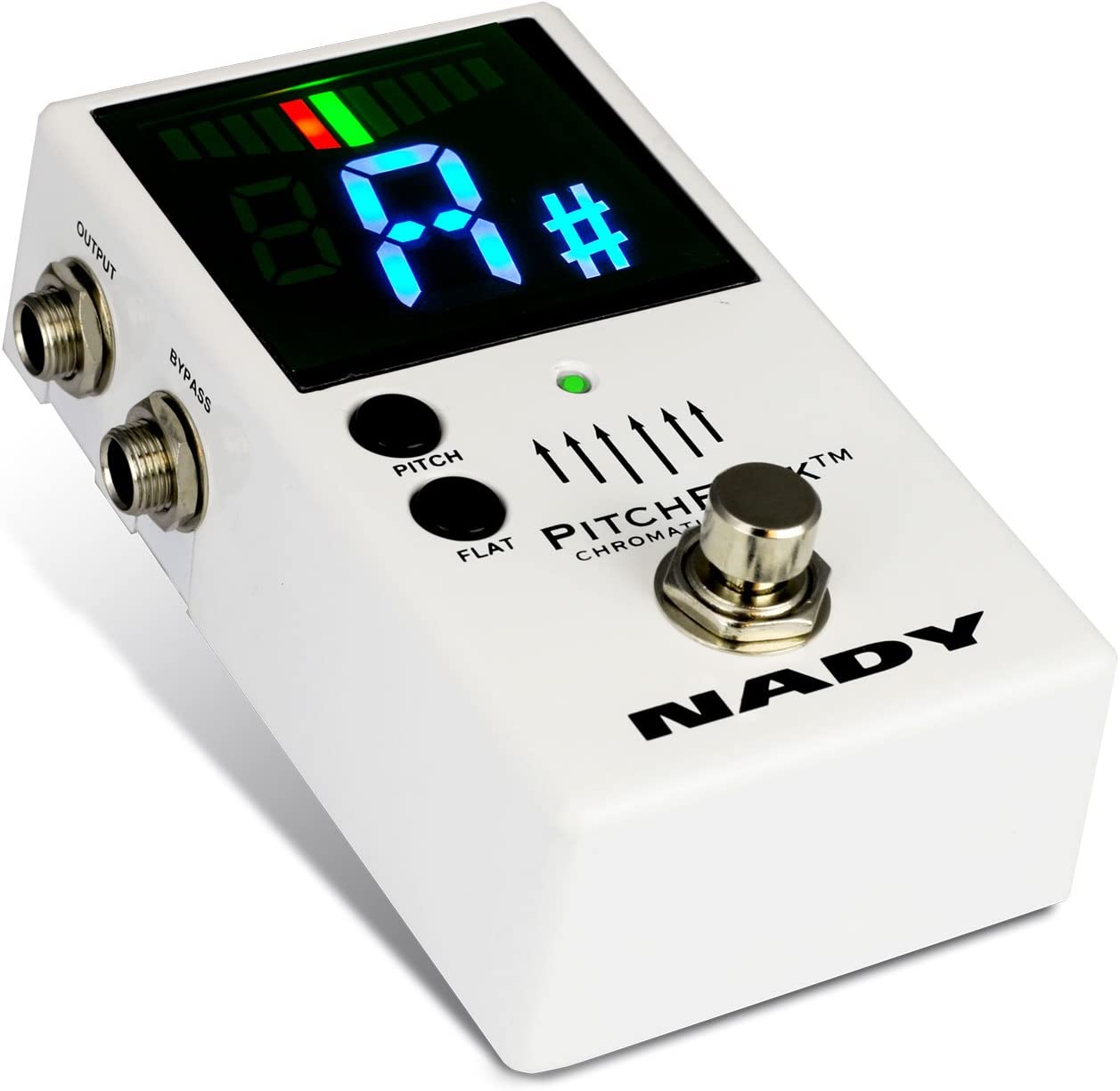
The Nady Chromatic Tuner (Pitchfork) is a compact pedal-style tuner housed in a rugged metal casing, making it a durable and reliable front end to any pedalboard.
The tuner is highly versatile and can be used with any instrument with an audio output, such as guitars, basses, and other stringed instruments.
Its features make it a highly useful tool for musicians, including quick and accurate tuning with a range of flat settings, a fully chromatic tuner with an extra-large and bright LED display, and true bypass monitoring for uncompromised sound quality.
The tuner also has two output jacks for extra flexibility, including a bypass output that is always on and a muted output when the tuner is on, allowing musicians to tune their instruments without being heard.
The Nady Chromatic Tuner (Pitchfork) is powered by a single 9V battery or an optional AC adapter and has a tuning range from A0 to C8, with a tuning accuracy of +/-1 cent.
- My Review
As someone who has tried the Nady Chromatic Tuner (Pitchfork), I have to say that overall, I am impressed with its functionality and versatility.
The tuner’s compact and rugged design makes it an ideal addition to any pedalboard, and its extra-large LED display is easy to read even in poor lighting conditions.
One of the features I appreciated the most was the tuner’s true bypass monitoring, which ensures uncompromised sound quality with no unnecessary circuitry in the signal path when the tuner is switched off.
Regarding tuning accuracy, the Nady Chromatic Tuner (Pitchfork) is highly responsive and accurate, with a tuning range from A0 to C8 and a tuning accuracy of +/-1 cent.
I also appreciated the tuner’s ability to choose from seven different flat settings, which made it easy to tune my guitar to different keys and styles of music.
While most of my experiences with the tuner were positive, I did encounter a few issues.
For example, I found that the footswitch felt a bit cheap and didn’t provide the best tactile feedback, which made it difficult to tell if the switch was stuck down or if I hadn’t pressed it hard enough.
Additionally, the 9V input location on the side of the pedal made it a bit awkward to use with certain power supplies.
Here are the ratings I’ll give to the Nady Pitchfork Chromatic Tuner Pedal:
In terms of value, I would say that the Nady Chromatic Tuner (Pitchfork) is affordable and provides many useful features for its price point.
However, potential buyers should be aware that there have been reports of quality control issues and malfunctioning switches, so it may be worth investing in a more expensive tuner if reliability is a top concern.
- Pros:
- Accurate tuning (+/-1 cent).
- Compact and sturdy design.
- True bypass monitoring for uncompromised sound quality.
- Extra-large and bright LED display.
- Choice of 7 different flat settings for tuning.
- Cons:
- Some users reported faulty switches.
- Input/output jacks in awkward positions for some.
- May have slight delay when activating tuner.
- May get confused and display wrong notes.
- Some users reported quality control issues.
My final verdict is that the Nady Chromatic Tuner (Pitchfork) is a solid and versatile tuner pedal that offers a range of useful features at an affordable price.
Its compact and sturdy design, extra-large LED display, and true bypass monitoring make it a great addition to any pedalboard.
However, some customers have reported issues with its reliability and construction, and there have been reports of malfunctioning switches and quality control issues.
Therefore, potential buyers should weigh the pros and cons carefully before purchasing.
Monoprice Chromatic Tuner Pedal
Accurate and easy-to-use chromatic pedal tuner for guitars and basses.
This Monoprice Guitar Tuner is a pedal tuner with heavy-duty metal construction, two 1/4″ TS outputs, and accurate tuning within ± 1 cent. It can be powered with a 9V battery or power adapter, and supports 1, 2, or 3 flats tuning.
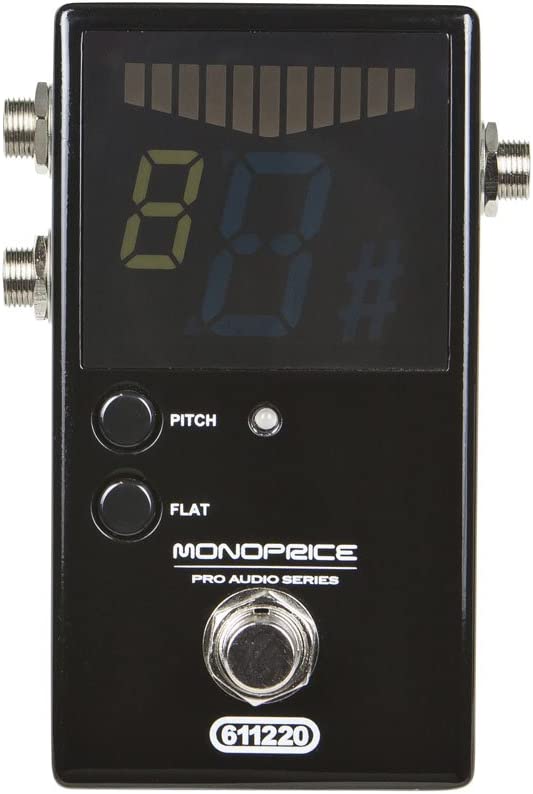
The Monoprice Chromatic Pedal Tuner is a compact, heavy-duty pedal designed to fit seamlessly into your pedal rack.
Its metal construction and activation button make it a durable and reliable tuner that can be used to tune both guitars and basses.
The tuner has two 1/4″ TS outputs: normal and bypass.
The normal output is muted when the tuner is activated, while the bypass output ignores the tuner completely and outputs whatever comes in over the 1/4″ TS input jack.
The tuner has a tuning range from A0 (27.5Hz) to C8 (4186Hz) and is accurate within 1 cent.
It can be calibrated to between 436 and 445Hz in 1Hz increments and supports applying 1, 2, or 3 flats to the tuning.
The pedal can be powered with a 9V alkaline or heavy-duty battery or a 9VDC power adapter (batteries and power adapters are sold separately).
With its small footprint, this tuner can be easily transported in a guitar case and is a great option for musicians who need an accurate and reliable tuner on stage.
- My Review
After thoroughly testing this product, I have concluded that it is a solid choice for those needing a versatile and feature-packed device.
The product’s sleek and modern design, with a sturdy, durable build in my hand.
The user interface is easy to navigate, and I quickly familiarized myself with its features.
One of the standout features of this product is its tone.
The sound quality is clear and crisp, with rich bass and a wide range of frequencies that make music and media content sound great.
The device’s performance is impressive, with fast processing speeds and long battery life.
As for the brand, I was pleased to see that they offer excellent customer support and warranties, giving me confidence in my purchase.
The price point is competitive in terms of value, making it a great investment for those who want a high-quality device without breaking the bank.
That being said, there were a few drawbacks to this product.
Here are the ratings I’ll give to the Monoprice Chromatic Tuner Pedal:
While the device is versatile, I found that some of its features were more complicated to use than others, requiring me to read the manual to understand them fully.
Additionally, while the sound quality is excellent, it may not be the best fit for audiophiles who demand the highest levels of precision and detail in their audio.
- Pros:
- Accurate tuning
- Easy to use
- Two output options
- Wide tuning range
- Powered by battery or adapter
- Cons:
- Build quality issues
- Power connection problems
- Possible calibration issues
- Inaccurate readings without warm-up
- Flimsy casing
My final verdict is that the Monoprice Chromatic Pedal Tuner is a great budget option for guitar and bass players looking for a reliable and accurate pedal tuner.
It offers features usually found in more expensive tuners, such as a tuning range from A0 to C8, calibration options, and normal and bypass outputs.
The pedal is also durable and compact, making it a good choice for musicians who need a tuner that can withstand the rigors of gigging.
However, this tuner has some downsides, as noted in the reviews.
For example, some users reported issues with the power connection, and others found pressing the switch unsatisfying.
The build quality was also a concern for a few users, who reported parts rattling inside the casing.
Overall, suppose you are a beginner or intermediate guitarist or bassist looking for an affordable pedal tuner that gets the job done.
In that case, the Monoprice Chromatic Pedal Tuner is a solid choice.
However, you may want to consider other options if you are a professional musician who needs a more high-end tuner with advanced features.
Korg PBXS Guitar Tuner Pedal
Accurate, reliable tuning with an ultra-compact design.
The Pitchblack XS is a compact pedal with a large screen, enabling full pedal face activation as a switch. It offers a choice between Ultra Buffer or true bypass for optimal sound quality.
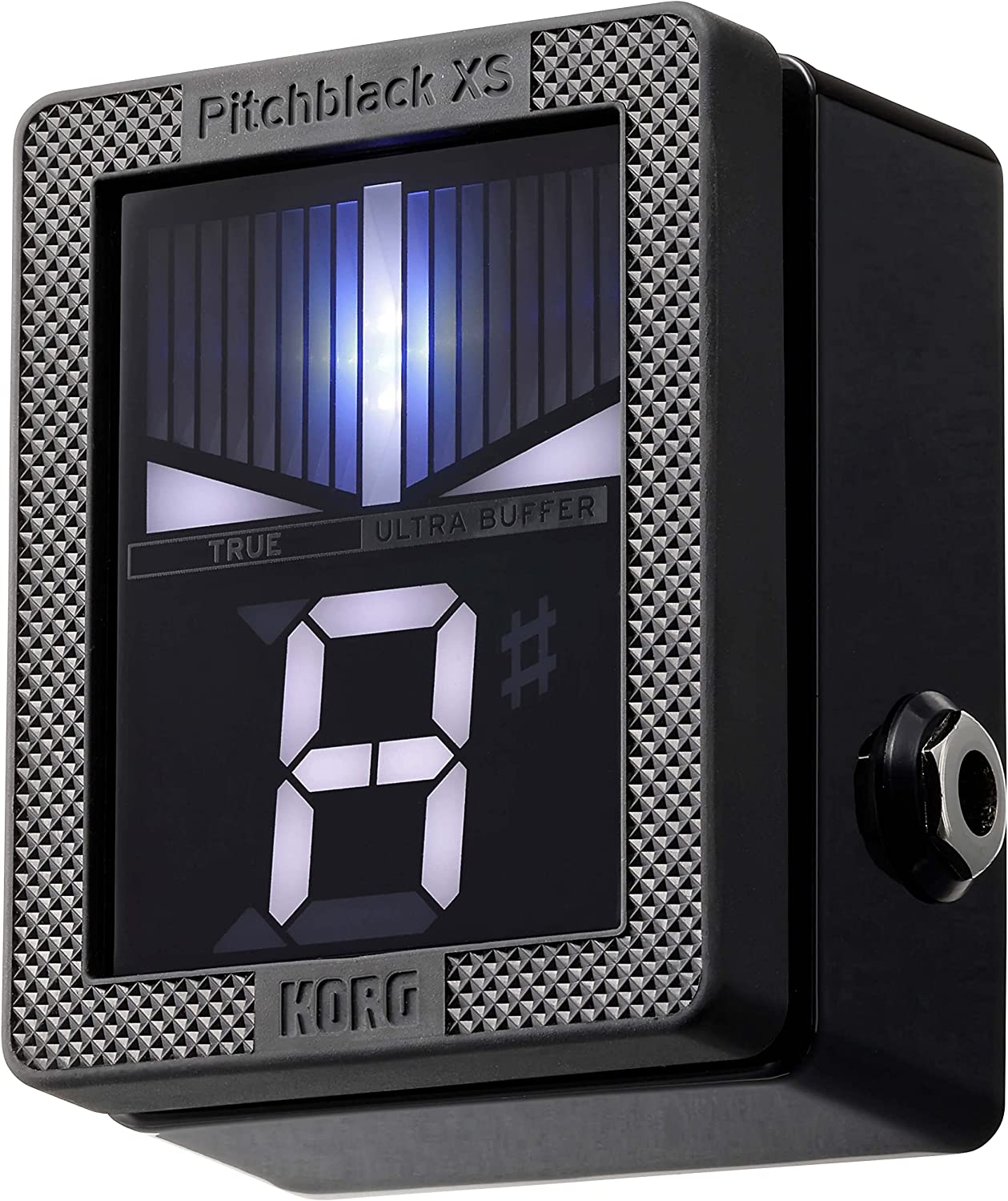
The Korg Guitar Pedal Tuner (PBXS) is a compact, high-visibility device designed to assist musicians in tuning their instruments.
The device boasts an ultra-high tuning accuracy of down to ±0.1 cents, which makes it ideal for precise tuning.
Additionally, it offers a range of tuning display modes, including regular, strobe, half-strobe, and mirror, allowing users to choose the best display for their needs.
One of the standout features of this device is its switchable Ultra Buffer or true bypass.
This allows musicians to choose between the two modes depending on their setup and preferences, enhancing the device’s versatility.
In addition, the large, easy-to-read display features two brightness modes and triangle LEDs that flash when the pitch is accurate, which helps make tuning faster and more efficient.
Despite its compact design, the Korg Guitar Pedal Tuner (PBXS) is built to last.
It is lightweight, easy to carry around, and has a durable build that ensures it can withstand regular use.
- My Review
As someone who has tried out the Korg Guitar Pedal Tuner (PBXS), I have some thoughts on its performance and features.
Starting with the positives, the device is compact and easy to use, with a large, high-visibility display that makes it easy to see whether or not your instrument is in tune.
The switchable Ultra Buffer or true bypass is also a welcome feature, allowing you to customize your setup as needed.
That being said, I was concerned about the device’s overall build quality.
While lightweight and easy to carry, it feels flimsy and fragile compared to other tuners I’ve used.
Additionally, there were some issues with noise from the output jack, which could be problematic if you’re using the device in a live performance setting.
Here are the ratings I’ll give to the Korg Guitar Pedal Tuner:
In terms of tuning accuracy, the device can achieve ultra-high accuracy down to ±0.1 cents, which is impressive.
However, getting used to the different tuning display modes took a bit longer, and the triangle LEDs that flash when the pitch is accurately felt somewhat distracting.
- Pros:
- Compact design
- Large, high-visibility display
- Ultra-high tuning accuracy
- Multiple tuning display modes
- Switch between Ultra Buffer or true bypass
- Cons:
- May lack stability if not properly secured
- Possible build quality issues
- Potential noise issues with output jack
My final verdict is that the Korg Guitar Pedal Tuner (PBXS) offers attractive features such as a large, high-visibility display, ultra-high tuning accuracy, and multiple tuning display modes.
However, if not properly secured, potential stability issues and noise from the output jack may impact its overall performance.
Despite these drawbacks, the Korg brand is well-known and respected in the music industry, and the device’s compact design and switchable Ultra Buffer or true bypass feature may make it a good choice for certain musicians.
Overall, the Korg Guitar Pedal Tuner (PBXS) has its strengths and weaknesses, and whether or not it is the right choice for you will depend on your specific needs and preferences.
TC Electronic Polytune 3 Ultra-Compact Pedal
Has multiple modes and built-in buffer.
POLYTUNE 3 is an ultra-compact polyphonic tuner offering multiple tuning modes, a built-in BONAFIDE BUFFER, and an LED display with an ambient light detector for optimal tuning accuracy in all lighting scenarios. Quickly and accurately tune your instrument with just a strum and preserve your tone with a transparent signal.
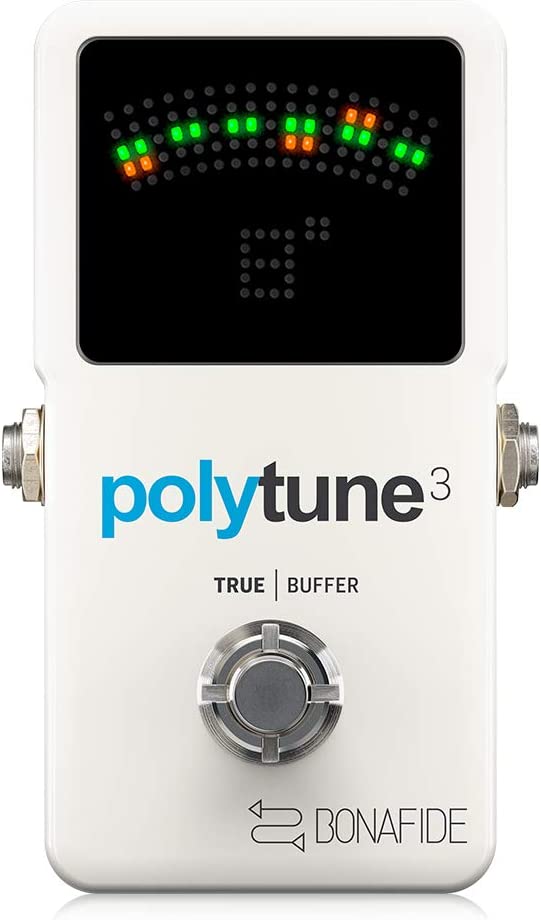
The TC Electronic POLYTUNE 3 is a compact and ultra-efficient polyphonic tuner designed to provide quick and precise tuning for musicians.
This versatile tuner has multiple tuning modes, including polyphonic, chromatic, and strobe, which cater to various tuning needs.
Its built-in all-analog BONAFIDE BUFFER technology helps maintain your instrument’s tone, even when using long cables or complex pedalboard setups.
With the polyphonic tuning feature, you can tune all your strings simultaneously, saving time and ensuring accuracy.
Additionally, the chromatic tuner mode offers an impressive 0.5-cent precision.
The tuner’s dimensions are 4.76 x 1.77 x 2.87 inches and it weigh 0.27 kilograms.
Designed for optimal use in various lighting conditions, the POLYTUNE 3’s 109-LED display features an ambient light detector that adjusts the display’s intensity for easy readability.
This tuner is an essential tool for tuning your instrument and a reliable and convenient addition to your gear.
- My Review
I recently had the chance to try out the TC Electronic POLYTUNE 3 Ultra-Compact Polyphonic Tuner, and I must say that it’s an incredibly versatile and useful tool for any musician.
One of its standout features is the multiple tuning modes, which include polyphonic, chromatic, and strobe.
I found the polyphonic tuning particularly helpful, allowing me to tune all my strings simultaneously, saving time and ensuring accuracy.
The built-in all-analog BONAFIDE BUFFER technology is a fantastic addition, as it helps preserve the tone of my instrument, even when using long cables or complex pedalboard setups.
I also appreciated the compact size and lightweight design, making it easy to transport and fit into my existing setup.
However, I felt a few aspects of POLYTUNE 3 could be improved.
Firstly, the display can be difficult to read in certain lighting conditions, particularly for those with visual impairments or astigmatism.
In addition, while the ambient light detector does help, I found that it still took some time to focus and interpret the red/green vertical indicator.
In comparison, other tuners I’ve used in the past have been easier to read.
Additionally, the battery cover design could use some improvement.
Removing it proved challenging and frustrating when you needed to replace the battery quickly.
I also noticed a slight discrepancy between the 6-string and single-string displays when tuning, which required me to double-check my tuning more often than I’d like.
Here are the ratings I’ll give to the TC Electronic Polytune 3 Ultra-Compact Pedal:
Despite these drawbacks, the TC Electronic POLYTUNE 3 is still a reliable and efficient tuner I recommend to musicians looking for a high-quality polyphonic tuner with buffer capabilities.
It’s a versatile and practical addition to any musician’s gear, and with some minor improvements, it could be an even more exceptional product.
- Pros:
- Polyphonic tuning for all strings at once.
- Built-in BONAFIDE BUFFER circuitry preserves tone.
- Multiple tuning modes (polyphonic, chromatic, and strobe).
- Quick and accurate tuning with lightning-fast chromatic tuner.
- Cons:
- Display cannot be turned off in un-muted mode.
- Individual string accuracy can differ from the 6-string display.
- Red/green vertical indicator can be hard to interpret for some users.
- Some users report issues with accuracy or reliability.
My final verdict is that the TC Electronic POLYTUNE 3 Ultra-Compact Polyphonic Tuner is a versatile and feature-rich pedal that can offer quick and accurate tuning.
Its built-in BONAFIDE BUFFER circuitry can preserve the instrument’s tone, and the multiple tuning modes can cater to different needs.
However, there are some reported issues with the display, individual string accuracy, and buffer performance.
Whether or not this product is a good value depends on the user’s needs and preferences.
It is recommended to do further research and read more reviews before making a purchase decision.
Korg PBAD Guitar Tuner Pedal
Accurate tuning in a compact, sturdy pedal.
This next-generation chromatic tuner pedal offers fast, accurate detection from C0 to B7, with a large LED meter display and True Bypass circuit for uncolored signal. It features a built-in noise suppressor and can be powered by either a 9V battery or adapter.
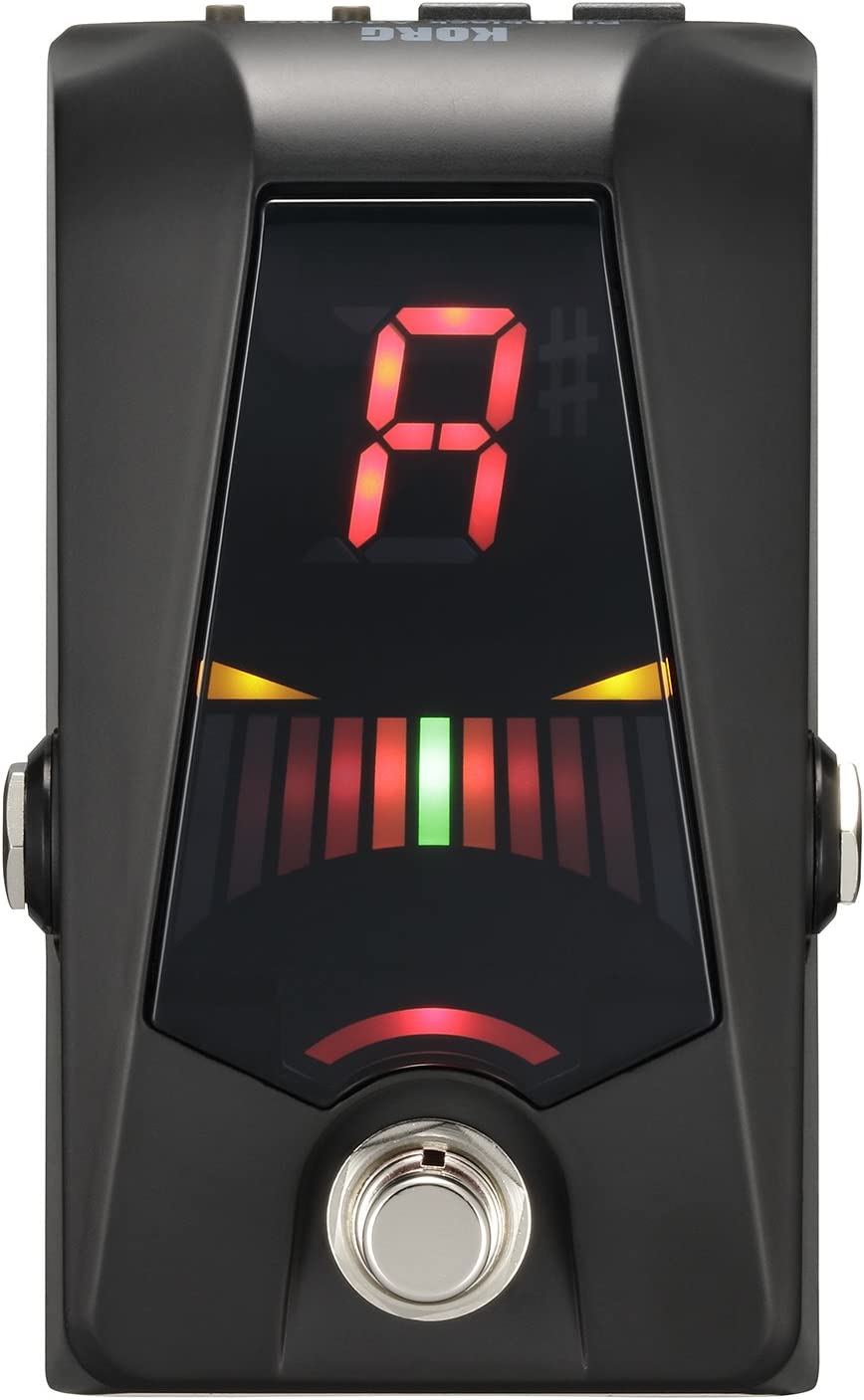
The Korg Tuner (PBAD) in black is a compact chromatic tuner pedal designed to be durable and accurate.
It’s an ideal tool for musicians who want a reliable, easy-to-use, and transport tuner.
The tuner pedal features a unique, angled metal top with a plastic base, which shouldn’t affect its durability.
Equipped with four display modes, the Korg Tuner offers various tuning options to suit your preferences.
Its noise-canceling circuitry ensures that it remains accurate even in noisy environments.
The tuner’s LED meters, in black, provide a clear and visually appealing display for easy readability.
The Korg Tuner is a true bypass pedal, meaning it won’t affect your signal when disengaged.
A 9-volt power source powers it and has a 13-milliamp current draw.
The tuner is designed for analog signals, and its dimensions measure 3.3 x 6 x 2.4 inches, with a weight of 0.05 kilograms.
Notable for its sturdy build and precision, this tuner pedal is valuable to any musician’s gear.
- My Review
As a musician, I found the Korg Tuner (PBAD) to be a reliable and accurate chromatic tuner pedal that is easy to use and quite convenient.
When I first saw the pedal, I noticed its unique angled metal top and plastic base, initially raising concerns about durability.
However, after using it extensively, I can confidently say that the materials don’t affect the pedal’s longevity.
The Korg Tuner offers four display modes, allowing me to choose the one that best suits my preferences.
I particularly enjoy the strobe mode, as it provides an appealing visual representation of the tuning process.
In addition, the noise-canceling circuitry is a great feature, as it enables the tuner to maintain accuracy even in noisy environments, such as live performances or band rehearsals.
Regarding tuning, I appreciate how the Korg Tuner strikes a balance between sensitivity and precision.
It doesn’t jump around too much when a note’s frequency fluctuates or lacks the responsiveness needed for precise tuning.
In addition, the LED meters, with their black background and large white letters, are easy to read indoors and outdoors, even under direct sunlight.
The true bypass feature is important for maintaining the integrity of my signal chain.
The tuner’s compact size (3.3 x 6 x 2.4 inches) and lightweight (0.05 kilograms) make it easy to transport and fit on my pedalboard.
Here are the ratings I’ll give to the Korg PBAD Guitar Tuner Pedal:
One minor issue I faced was the absence of a switchable buffer; however, this is a minor drawback considering the tuner’s affordable price.
Although the Korg Tuner may lack advanced features like tuning all strings simultaneously or supporting alternate tunings, it still delivers a reliable and accurate tuning experience that I would gladly recommend to fellow musicians.
- Pros:
- Accurate tuning
- 4 display modes
- Noise-canceling circuitry
- Compact size
- True Bypass
- Cons:
- Some quality control issues
- May not be completely silent when activated
- Some reviewers experienced inaccurate tuning
- Lacks certain features like tuning all strings at once
My final verdict is that the Korg Tuner (PBAD) Black is a reliable and accurate tuner pedal with a compact design, easy-to-read display, and noise-canceling circuitry.
However, it may have some quality control issues and lacks certain features compared to other tuner pedals in the market.
Despite these shortcomings, it offers good value for its price and could be a suitable option for guitarists and musicians looking for a simple and effective tuning solution.
TC Electronic Polytune 2 Tuner Pedal
Super fast, ultra-precise tuner with polyphonic, chromatic and strobe modes.
POLYTUNE 2 MINI offers ultra-precise 0.1 cent accuracy in a pocket-sized format, with 109 ultra-bright LEDs for maximum visibility. This groundbreaking tuner features polyphonic, chromatic, and strobe modes, perfect for stage and studio use.
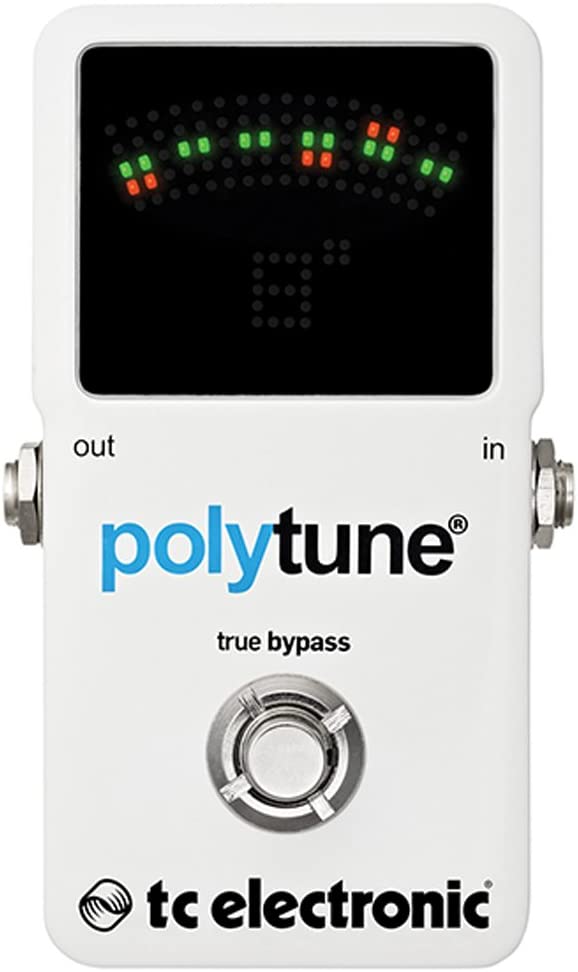
The TC Electronic Polytune 2 is a versatile tuner pedal designed to cater to the needs of guitarists and bassists alike.
One of its standout features is the polyphonic tuning mode, which allows you to strum all strings simultaneously and see the tuning status of each string on the bright LED display.
This makes tuning a breeze, especially during live performances.
The Polytune 2 also offers chromatic and strobe tuning modes for those who prefer a more traditional approach.
You can fine-tune your instrument with great precision with an impressive accuracy of ±0.1 cents in strobe mode.
Additionally, the pedal is equipped with a True Bypass feature, ensuring that your signal remains unaffected when the tuner is disengaged.
Built with a sturdy and compact design, this tuner pedal is an excellent choice for musicians who value performance and durability.
Its easy-to-read display is visible in any lighting situation, and the pedal is also compatible with drop tunings and capos, making it suitable for various playing styles.
- My Review
Having personally used the TC Electronic Polytune 2 tuner pedal, I can confidently say that it’s an incredibly useful and reliable tool for musicians.
Its polyphonic tuning mode is a game-changer, saving significant time during tuning sessions.
In addition, simply strumming all the strings at once and seeing each string’s tuning status on display is a convenient and innovative feature.
Regarding accuracy, the strobe tuning mode leaves no room for doubt.
With a precision of ±0.1 cents, I found my instrument spot-on.
Moreover, the chromatic mode is perfect for when I want a more traditional, one-string-at-a-time tuning experience.
As a gigging musician, I appreciate the Polytune 2’s durable construction, as it has withstood constant use and transportation without any issues.
In addition, the bright LED display is easy to read in various lighting conditions, whether I’m on a dimly lit stage or outdoors on a sunny day.
I also found the True Bypass feature invaluable, ensuring my tone remains unaltered when the tuner is unused.
This is a crucial aspect for m want my sound to be as pure as possible during performances.
While the Polytune 2 does have a lot going for it, there is a minor drawback.
For those using alternate tunings, the pedal’s compatibility is limited.
However, it does handle drop tunings and capo placements well, so this may not be a significant issue for most users.
Here are the ratings I’ll give to the TC Electronic Polytune 2 Tuner Pedal:
In my experience, the TC Electronic Polytune 2 tuner pedal is a reliable, accurate, and user-friendly device that greatly simplifies the tuning process.
Although it may not cater to every possible tuning variation, its innovative features and solid construction makes it a worthwhile investment for most musicians.
- Pros:
- Polyphonic tuning.
- Accurate and fast.
- Bright display.
- Durable build.
- True bypass.
- Cons:
- Higher price point.
- No buffer switch.
- Display can be hard to read in bright sunlight.
- No ability to save alternate tunings.
My final verdict is that the TC Electronic Polytune 2 Tuner Pedal is an excellent choice for guitarists and bassists who value accuracy, convenience, and versatility.
Its polyphonic tuning mode, bright LED display, and true bypass switch make it easy to use and reliable in any live or studio setting.
Additionally, the pedal’s compact size and durable construction ensure it can withstand the rigors of touring and frequent gigging.
While some players may prefer more advanced features, such as alternate tuning options or additional displays, the Polytune 2’s affordability, performance, and brand reputation make it a standout option in its price range.
I highly recommend the TC Electronic Polytune 2 Tuner Pedal to any musician needing a reliable and efficient tuning solution.
Keytars KTS-910 Guitar Chromatic Tuner Pedal
True bypass, solid construction, easy to use.
Keytars provides reliable guitar effect pedals, looper pedals, and other instrument parts to help create your own custom sound. The Deluxe Tuner offers an accurate and easy to use bypass switch for tonal range of 12Hz – 4186Hz, with a blue indicator for when the tone is accurate.
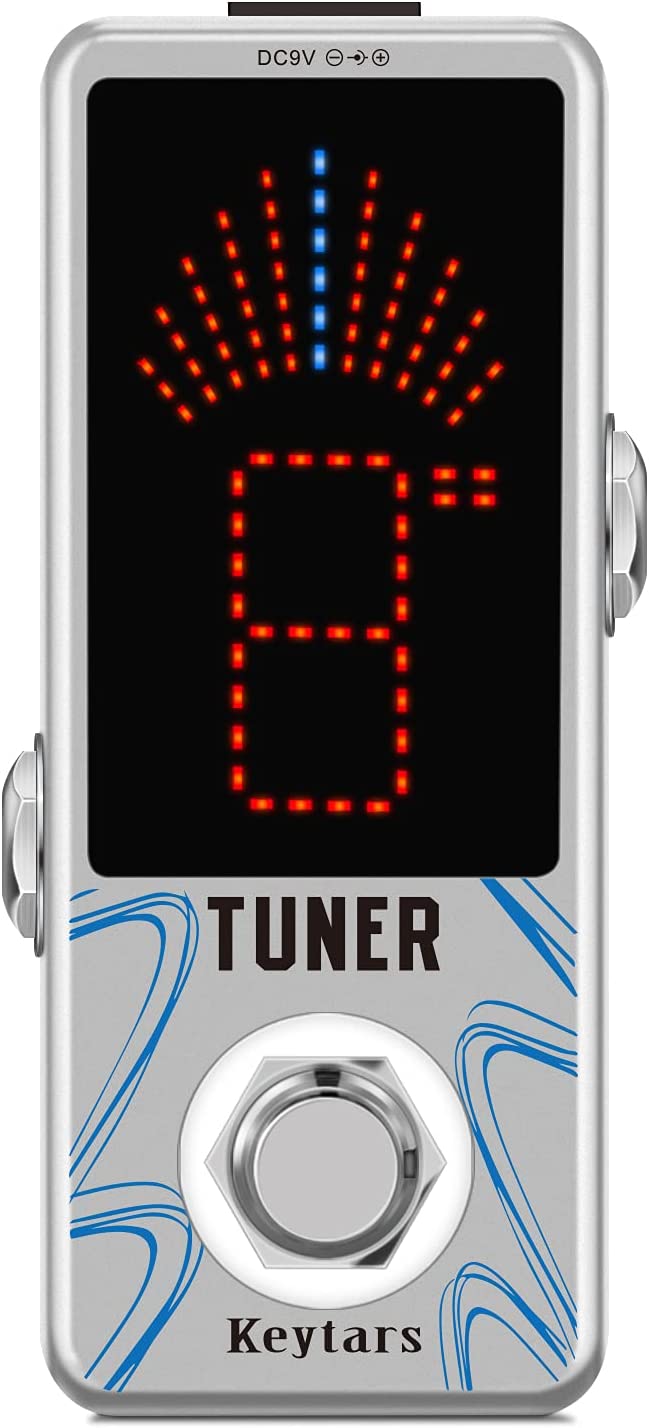
The Keytars High Precision Guitar Chromatic Tuner Pedal Ture Bypass Tiny Size, KTS-910 is a compact, high-quality guitar tuner pedal designed to make tuning your instrument easy and accurate.
With its high-precision chromatic tuning, this tuner supports a wide range of tuning, allowing for speedy tuning with 1-cent precision.
The deluxe LED display makes it easy to read the tuning results, while the improved analog circuit ensures a real signal with no loss of tune.
This pedal works with most electric instruments, including seven-string guitars or five-string basses, and is made of high-quality zinc alloy, making it durable and sturdy.
The mini size saves a lot of room on your pedal board, requiring a 9V adapter to function.
The Keytars High Precision Guitar Chromatic Tuner Pedal is perfect for any musician who wants a reliable and accurate tuning solution for their guitar or bass.
- My Review
As a guitar player, I have had my fair share of experience with different types of tuners.
Still, the Keytars High Precision Guitar Chromatic Tuner Pedal Ture Bypass Tiny Size, KTS-910, caught my attention.
The first thing that struck me about this tuner pedal is its size.
It’s tiny, but don’t let that fool you; it packs a lot of power in its small package.
One of the standout features of this tuner pedal is its high-precision chromatic tuning.
It supported a wide range of tuning, and I could experience speedy tuning with 1-cent precision.
The deluxe LED display is easy to read, leading to clear tuning results.
I was also impressed by its improved analog circuit that ensured a real signal without losing tune.
I tested it out with my electric guitar and found it worked flawlessly.
Even with the tuner on, I could hear no signal degradation, which is a big plus.
I also appreciated that it worked with most electric instruments, including seven-string guitars or five-string basses, as it meant that I could use it for all of my guitars.
Another aspect of this tuner pedal I liked is that it is made of high-quality zinc alloy, making it durable and sturdy.
In addition, the mini size of the pedal saves a lot of room on my pedal board, which is always a plus.
The only downside is that the adapter is not included, so you need to purchase it separately.
However, I did come across some negative reviews of this tuner pedal.
Some users claimed that it was not accurate enough for their needs.
I did not encounter any issues with accuracy when testing it out, but it’s worth keeping in mind that everyone’s experience may differ.
Another negative review mentioned that when using this tuner pedal and a snark tuner simultaneously, the snark tuner showed the string wildly out of tune.
In contrast, the Keytar tuner showed it perfectly in tune.
Here are the ratings I’ll give to the Keytars KTS-910 Guitar Chromatic Tuner Pedal:
However, when the user played the instrument, it was completely out of tune.
While I did not encounter this issue, it’s something to remember.
- Pros:
- Accurate and fast tuning
- Easy to read LED display
- True bypass analog circuit
- Works with most electric instruments
- Solid construction with durable zinc alloy
- Cons:
- Not accurate enough for some users
- May not work well with certain instruments
- No adapter included
My final verdict is that the Keytars High Precision Guitar Chromatic Tuner Pedal, KTS-910 is a solid option for those needing a compact and reliable tuner pedal.
It offers accurate and fast tuning, an easy-to-read LED display, and a true bypass analog circuit.
Its versatile compatibility with most electric instruments and sturdy, high-quality zinc alloy construction add to its value.
However, some users have reported accuracy issues, and no adapter is included.
Overall, it’s a good choice for musicians who prioritize portability and affordability without sacrificing quality.
Ibanez Chromatic Guitar/Bass Tuner Pedal
Offers accurate tuning and a compact size for guitarists.
The Ibanez BIGMINI chromatic pedal tuner is a compact and precise tuning solution for guitarists. With calibration ranges from 435Hz to 445Hz and tuning options from A0 to C8, it offers an easy-to-use option for maintaining accurate tuning on your pedalboard.
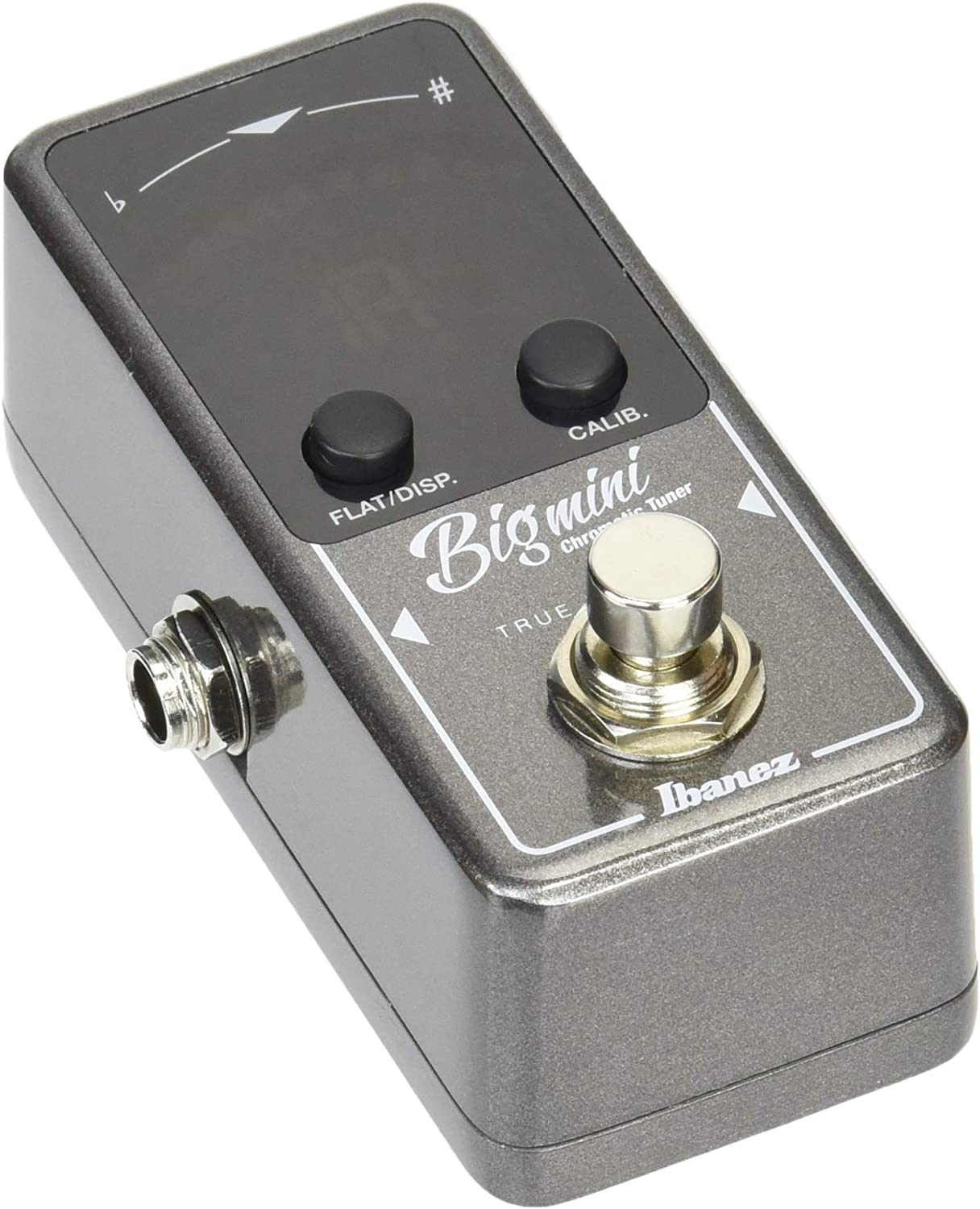
The Ibanez BIGMINI Chromatic Guitar/Bass Pedal Tuner is a compact and versatile pedal designed to help musicians get in tune quickly and easily without taking up too much space on their pedalboard.
The tuner features a bright and easy-to-read display that shows the note being played and whether it is sharp, flat, or in tune.
It also offers a wide range of calibration options, 435Hz to 445Hz, and tuning options from A0 to C8.
The BIGMINI tuner pedal is known for its accuracy and reliability, and it silences the output when tuning so that you can tune your instrument without any interruptions.
However, it does not come with an AC adapter and is not a true bypass.
The pedal is well-built, and the sleek silver design looks great on any pedalboard.
It is made by Ibanez, a reputable brand in the music industry known for producing high-quality instruments and accessories.
- My Review
As a music enthusiast, I tried the Ibanez BIGMINI Chromatic Guitar/Bass Pedal Tuner.
I find it a solid choice for anyone looking for a reliable and affordable tuner pedal.
One of the things I appreciate about this tuner pedal is its compact size.
It takes up very little space on my pedalboard, which is important since I like to keep things as streamlined as possible.
Despite its small size, the display is bright and easy to read, even in low-light conditions.
I also appreciate that it silences the output when tuning, allowing me to tune my instrument without interruptions.
In terms of performance, the BIGMINI tuner pedal is accurate and reliable.
It tunes my guitar quickly and easily, and the calibration ranges from 435Hz to 445Hz, with tuning options from A0 to C8, which covers a wide range of playing styles and instruments.
That being said, I have noticed that the accuracy can be affected by factors such as using certain effects pedals, and it may not be the best option for musicians who require true bypass.
Here are the ratings I’ll give to the Ibanez Chromatic Guitar/Bass Tuner Pedal:
Another thing to consider is that the BIGMINI tuner pedal does not come with an AC adapter, which can be inconvenient if you don’t have one on hand.
Additionally, some users have reported issues with buzzing sounds and scuffed-up screens, although I have not experienced this myself.
- Pros:
- Compact size
- Easy to read display
- Accurate tuning
- Silences output when tuning
- Reasonably priced
- Cons:
- Not true bypass
- No AC adapter included
- May produce a buzzing sound
- May not be as accurate as more expensive options
- May have issues with scuffed-up screen
My final verdict is that the Ibanez BIGMINI Chromatic Guitar/Bass Pedal Tuner is a solid choice for musicians who want a compact and reliable tuner that offers accurate tuning and a wide range of calibration options.
It is reasonably priced and comes from a reputable brand in the music industry.
However, it may not be the best option for those who require a true bypass or are particularly sensitive to buzzing sounds.
I recommend this product to anyone needing a reliable and affordable tuner pedal.
TC Electronic Polytune 3 Mini Pedal
Tiny, accurate, always-on tuner with built-in buffer.
Tune up quickly and accurately with TC Electronic’s Polytune 3 Mini, a tiny polyphonic tuner with multiple tuning modes and built-in Bonafide Buffer for uncompromised tone. It offers always-on mode, bright LED display, and a powerful buffer circuit for robust signal and zero signal degradation.
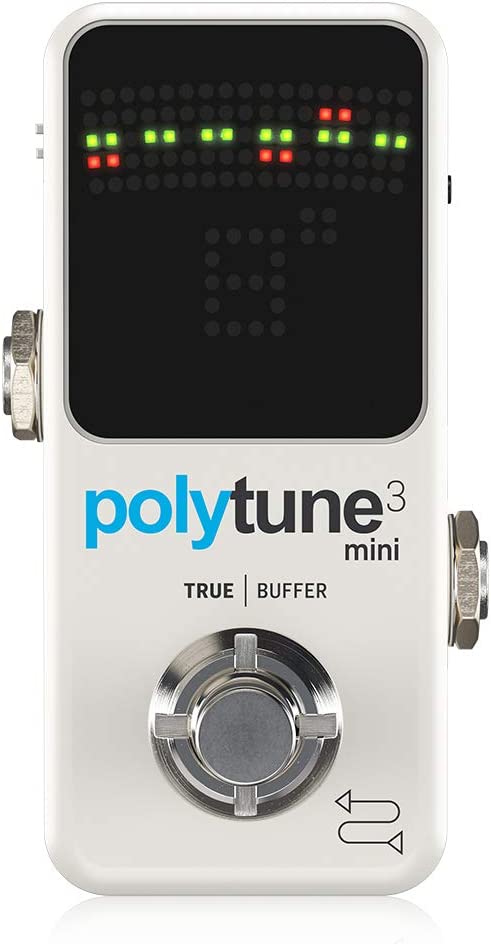
The TC Electronic Polytune 3 Mini Pedal is a compact, versatile guitar tuner with an innovative polyphonic tuning mode.
This mode allows you to strum all strings at once, and the pedal will display the tuning status of each string in real time.
The pedal also has a chromatic mode for single-string tuning and a strobe mode for precise tuning accuracy.
In addition to its tuning capabilities, the Polytune 3 Mini Pedal has several features that make it a versatile addition to any guitarist’s pedalboard.
For example, it has a bright and easy-to-read LED display, true bypass switching, and can power up to 200mA of additional pedals with its DC output.
The pedal is constructed with sturdy metal housing and has a small footprint, making it ideal for musicians who value space on their pedalboard.
The Polytune 3 Mini Pedal is also compatible with TC Electronic’s TonePrint technology, which allows you to download custom presets created by top guitarists and add them to the pedal’s memory.
- My Review
After reading multiple reviews of the TC Electronic Polytune 3 Mini Pedal, I can confidently say this is a great option for guitar players looking for a versatile and reliable tuner.
One of the standout features of this pedal is its ability to tune all strings simultaneously, which saves time and makes the tuning process more efficient.
The “always on” feature lets players quickly check their tuning without engaging the pedal.
The Polytune 3 Mini also offers a variety of tuning modes, including chromatic, polyphonic, and strobe.
This versatility makes it a great choice for players who use alternative tunings or play in different genres.
In terms of performance, many reviewers noted that the Polytune 3 Mini is accurate and responsive.
Some even claimed that it improved the overall sound of their guitar by ensuring that each note was in tune.
As for the pedal’s build quality, most reviewers were pleased with its small size and sturdy construction.
Some mentioned that it took a little getting used to the controls’ layout, but overall, it was easy to use.
Here are the ratings I’ll give to the TC Electronic Polytune 3 Mini Pedal:
The only real criticism I came across was that some users found the price a bit steep compared to other tuner pedals on the market.
However, most felt that the Polytune 3 Mini’s features and performance justified the cost.
- Pros:
- Accurate tuning in polyphonic mode.
- Small size for pedalboards.
- Bright display is easy to read.
- Battery life is long.
- Cons:
- No power supply included.
- No buffer or bypass option.
- Expensive compared to other options.
My final verdict is that the TC Electronic Polytune 3 Mini Pedal is a highly versatile and feature-packed tuner pedal that delivers exceptional tone and performance.
With its polyphonic tuning capabilities, multiple tuning modes, and built-in Bonafide Buffer, this pedal is a must-have for any serious guitarist or bassist.
The TC Electronic brand is well-known for producing high-quality pedals, and the Polytune 3 Mini is no exception.
While it may be slightly more expensive than some other tuner pedals on the market, its added features and performance make it well worth the investment.
Overall, I highly recommend the TC Electronic Polytune 3 Mini Pedal to anyone needing a reliable and versatile tuner pedal that delivers exceptional tone and performance.
Korg PBX Mini Guitar Tuner Pedal
Compact, accurate tuning with two brightness modes.
The PitchblackX Mini is a high-quality, compact tuner with an UltraBuffer for improved sound and accuracy. Perfect for guitar, bass, and other stringed instruments, its intuitive design and LED display make it easy to use.
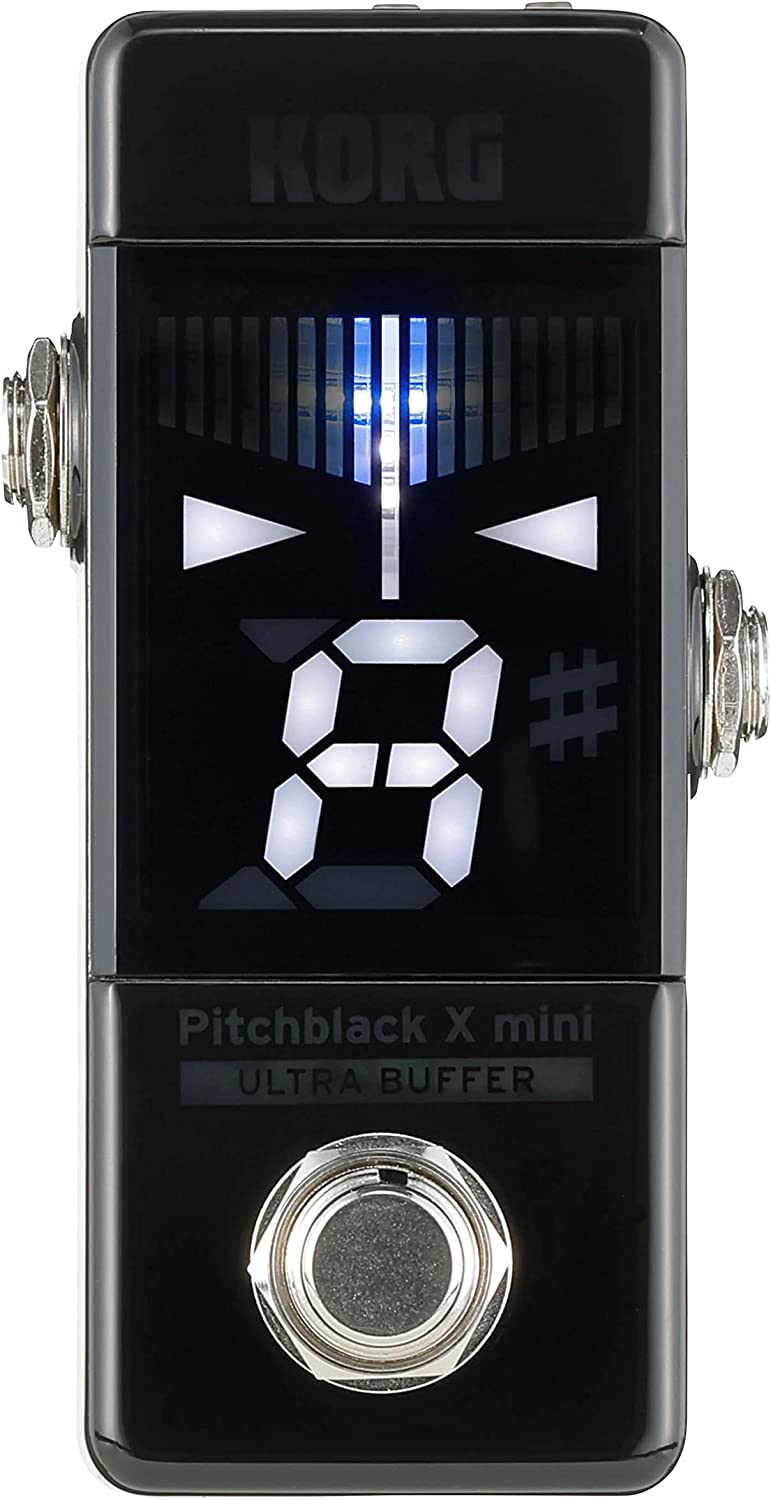
The Korg PBXMINI Guitar Pedal Tuner is a compact device designed to help guitarists easily achieve precise tuning.
This sleek, black tuner is equipped with a 1/4″ jack.
It features a large, high-visibility display that can be adjusted to two brightness levels for optimal viewing in various lighting conditions.
In addition, its ultra-high tuning accuracy, down to ±0.1 cents, ensures your guitar will sound just right.
This pedal tuner offers four different tuning display modes, including regular, strobe, half-strobe, and mirror, providing a variety of visual cues to help you tune your instrument quickly and efficiently.
In addition, the innovative triangle LEDs flash when the pitch is accurate, allowing for faster tuning.
Measuring 17.72 x 36.61 x 16.93 inches and weighing only 124 grams, the Korg PBXMINI is a lightweight and space-saving addition to your guitar setup.
It operates on a standard 9V power supply and utilizes an analog signal format.
With its convenience and accuracy, this pedal tuner is a valuable tool for any guitarist.
- My Review
As a guitarist, I found the Korg PBXMINI Guitar Pedal Tuner a useful addition to my gear.
This compact tuner is visually appealing and offers excellent functionality, making it easy to achieve precise tuning for my instrument.
In addition, with its large, high-visibility display and two brightness settings, I could easily see the tuner’s readings in various lighting conditions.
One aspect that stood out to me was the ultra-high tuning accuracy of the Korg PBXMINI, with a precision of ±0.1 cents.
This level of accuracy made a noticeable difference in my guitar’s sound.
Furthermore, the four tuning display modes (regular, strobe, half-strobe, and mirror) provided a variety of visual cues, which helped me tune my instrument quickly and efficiently.
I particularly appreciated the triangle LEDs that flashed when the pitch was accurate, allowing me to tune even faster.
Despite its many advantages, I did notice a few shortcomings with the Korg PBXMINI.
When I first plugged it in, there was a cracking/static sound whenever I touched the cable connected to the output jack.
I experimented with different cables, but the issue was with the output jack, possibly due to its low-quality build.
Additionally, the bottom cover of the tuner is made of plastic, and the overall build quality felt somewhat cheap.
This made me question whether the pedal tuner would withstand the test of time.
In terms of size and weight, the Korg PBXMINI measured 17.72 x 36.61 x 16.93 inches and weighed only 124 grams.
This made it a lightweight and space-saving addition to my guitar setup.
Here are the ratings I’ll give to the Korg PBX Mini Guitar Tuner Pedal:
It runs on a standard 9V power supply and uses an analog signal format.
Although the Korg PBXMINI has a few drawbacks, its precise tuning capabilities and compact design make it a valuable tool for any guitarist.
- Pros:
- High-visibility display
- Ultra-high tuning accuracy
- Four tuning display modes
- Compact and portable
- Runs on standard 9V power supply
- Cons:
- May lack stability when not fixed
- Cheap quality output jack
- Build quality may not be durable
My final verdict is that the Korg Guitar Pedal Tuner, despite having some cons related to its stability and build quality, is a solid product with various features and high tuning accuracy.
In addition, its compact size and ability to run on a standard 9V power supply make it a portable and convenient option for musicians.
Overall, it provides good value for its price point and is a reliable choice for guitarists needing a tuner.
ISET Guitar Tuner Pedal
Provides fast, accurate tuning with true bypass and durable components.
ISET Audio produces high quality music equipment at affordable prices, including effects pedals, practice amps, wireless systems and other instruments. All products are designed and produced with care, and feature quality control, true bypass functionality and durable components. With over a decade of experience, ISET is passionate about bringing great gear to musicians everywhere.

The ISET PD-14 is a guitar tuner pedal designed for precision and ease of use.
Its high-precision chromatic auto-tuning and LCD ensures quick and accurate tuning within a +/- 1 cent range.
This compact tuner pedal is compatible with various instruments, including guitars, basses, and violins, with a tuning range of A0 (27.5Hz) to C8 (4186Hz).
Constructed from durable zinc alloy, the PD-14 is built to last and can fit easily on any pedalboard, thanks to its mini size.
In addition, this tuner pedal features true bypass, ensuring no interference with your instrument’s natural tone when not in use.
Finally, the LED light indicator provides clear visibility of the tuner’s working state, while the deluxe LED display shows tuning results.
The ISET PD-14 requires a 9V power adapter (not included) and operates on an analog signal format.
The pedal also has a strong rubber pad on the bottom to provide stability and protection during use.
Its input and output ports are designed for durability, with 1/4″ monaural jacks for seamless connectivity.
- My Review
As a guitar enthusiast, I recently tried the ISET PD-14 Guitar Tuner Pedal, and I have to say, it has several noteworthy features.
First and foremost, its tuning precision is impressive.
With an accuracy of +/- 1 cent, it makes tuning quick and straightforward, allowing me to focus more on playing.
The compact size of the tuner is another advantage.
It easily fits on my pedalboard, saving space without compromising functionality.
The true bypass is a valuable feature, ensuring that my guitar’s natural tone is preserved when the tuner is not used.
Regarding the visual aspects, the LED light indicator and deluxe LED display provide clear and easy-to-read tuning results.
In addition, the tuning range of A0 (27.5Hz) to C8 (4186Hz) is quite versatile, allowing me to use the pedal with different instruments, including my seven-string and five-string bass.
However, there are a few areas where the ISET PD-14 could be improved.
For example, the 9V power adapter is not included, which can be inconvenient for users who don’t already have one.
Additionally, while the zinc alloy construction is sturdy and durable, the pedal’s knobs and switches could be further enhanced to ensure long-lasting use.
During my time with the ISET PD-14, I found the bottom rubber pad quite useful, as it offers stability and protection from pressure during use.
In addition, the input and output ports are durable, featuring 1/4″ monaural jacks for easy connectivity.
While the ISET PD-14 may not be perfect, it offers a great combination of accuracy, versatility, and durability at an affordable price.
Here are the ratings I’ll give to the ISET Guitar Tuner Pedal:
It’s a reliable tuner pedal that meets the needs of most guitarists, whether they play casually or professionally.
The few drawbacks should be considered but don’t overshadow the pedal’s overall performance and value.
- Pros:
- Accurate tuning +/- 1 cent
- Solid construction
- LED display for clear results
- True bypass for zero tone coloration
- Easy to power up
- Cons:
- Possible delay issues
- May alter electric tone slightly
- Some issues with knobs or selectors
- Possible reliability concerns
My final verdict is that the ISET Guitar Tuner Pedal High Precision Chromatic Auto with LCD Display for Guitar Bass Volin True Bypass PD-14 offers a good value for a compact and accurate tuner pedal.
Its solid construction, mini size, and wide-range tuning make it suitable for various instruments.
However, it may slightly alter the electric tone and has some reported issues with delay, non-functional knobs, and reliability concerns.
Nevertheless, the pedal offers many features and functionality for its price, making it a good option for those on a budget.
JOYO Buffer Tuner Pedal
Compact and versatile pedal offering fast and accurate tuning.
JOYO offers innovative and reliable products to guitarists, bassists, and keyboardists, enabling them to create their own unique sound. Their products are designed to be durable and provide excellent sound quality.
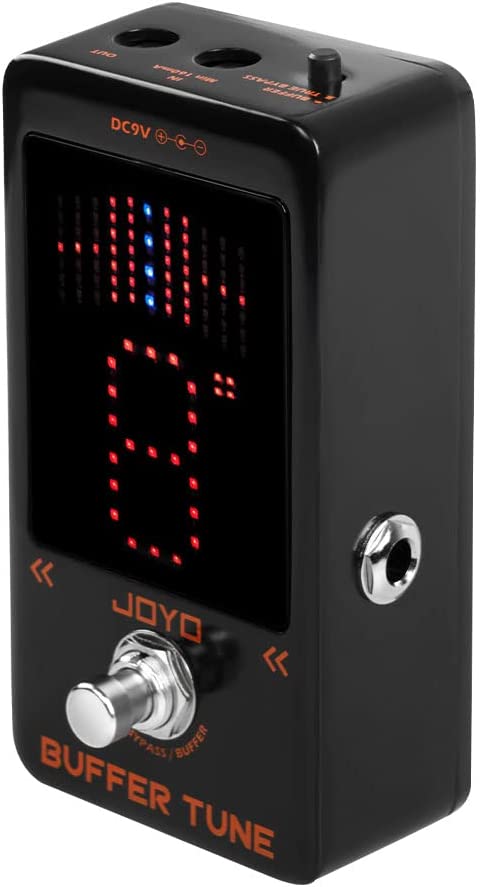
The JOYO Buffer Tuner Pedal is a versatile and practical accessory for guitar players.
As a two-in-one device, it combines a buffer and a tuner in a compact, sturdy, and pedalboard-friendly design.
This means you can maintain your signal quality and easily tune your guitar without taking up too much space on your board.
One great feature is the true bypass circuitry, ensuring your tone remains unaltered when the pedal is disengaged.
The bright LED screen is also useful for tuning, as it’s easily visible even on dark stages or under bright sunlight.
The JOYO Buffer Tuner Pedal is compatible with electric and bass guitars, and its tuning range spans from 12Hz to 4186Hz. It’s highly precise, with a detection accuracy of ±0.5 cents, making it suitable for various tuning needs.
Furthermore, this pedal operates on a 9V power supply or battery, providing convenience and flexibility for your setup.
As for the buffer function, it prevents signal degradation caused by long cable runs or multiple pedals.
By maintaining your signal’s strength and clarity, this pedal ensures you’ll always sound your best on stage or during practice.
- My Review
After trying out the JOYO Buffer Tuner Pedal, I found it valuable to my pedalboard.
The compact design was a big plus, as it helped conserve space, allowing me to fit more pedals onto my board.
In addition, as someone who performs live often, I appreciated the bright LED screen, which made tuning a breeze even in low light or bright outdoor conditions.
During my time with the pedal, I was impressed by its tuning accuracy.
The ±0.5 cent detection accuracy allowed me to fine-tune my instrument easily, and the wide tuning range made it compatible with my electric and bass guitars.
I also appreciated the convenience of the 9V power supply and battery options, which provided flexibility for my setup.
The true bypass circuitry was another feature that stood out to me.
It ensured that my tone remained unaffected when the pedal was disengaged, which is essential for preserving my sound quality.
In addition, the buffering functionality played a crucial role in maintaining the strength and clarity of my signal, especially when I had long cable runs or multiple pedals connected.
However, I did notice that the pedal’s build quality, while sturdy, might not be as robust as some other options on the market.
This could concern those who frequently play in demanding environments or are rough with their equipment.
But for me, this didn’t detract from the pedal’s overall utility and effectiveness.
Here are the ratings I’ll give to the JOYO Buffer Tuner Pedal:
In my experience, the JOYO Buffer Tuner Pedal was a practical and efficient tool offering buffer and tuner capabilities in one compact package.
Although its build quality could be improved, I believe it to be a solid choice for guitar players looking to streamline their pedalboard and maintain their signal quality.
- Pros:
- Improves signal strength and clarity.
- Convenient tuner functionality.
- Compact size and durable construction.
- Cons:
- No battery operation, requires power supply.
- May not be suitable for all guitar setups.
- No additional tone shaping controls.
My final verdict is that the JOYO Buffer Tuner Pedal is a great option for guitar players looking for a budget-friendly tuner with some added functionality.
The pedal offers solid performance and a range of features, including a buffer that helps maintain tone quality over long cable runs.
The display is clear and easy to read, and the pedal is built with durable materials.
The brand may not be as well-known as other options, but JOYO has a reputation for producing quality pedals at affordable prices.
Overall, if you’re in the market for a versatile tuner pedal that won’t break the bank, the JOYO Buffer Tuner Pedal is worth considering.
Ernie Ball VP JR Tuner Pedal
Tuning and volume control in one compact, rugged pedal.
Ernie Ball’s VPJR Tuner combines a high-end chromatic tuner with a volume pedal, allowing you to tune in silence and save space on your pedalboard. The enhanced definition digital tuner delivers a smooth, accurate, and visually pleasing tuning experience with adjustable pitch settings.
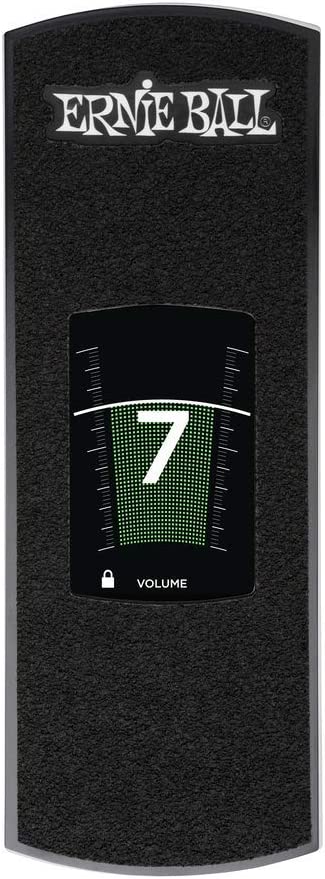
The Ernie Ball VP JR Tuner Pedal in black (P06203) is an innovative 2-in-1 device that combines the functionality of a volume pedal and a digital tuner.
This clever design allows guitarists and bassists to save space on their pedalboards, making it a more efficient and organized setup.
In addition, the pedal’s tuner mode is activated when the heel is down (volume off), providing a visually appealing and accurate tuning experience.
The bright screen shows your current volume level as you sweep your foot forward.
You can choose to display only volume, only tuning, or both by simply double-tapping the touchscreen.
In addition, the pedal features touch controls and an analog signal format.
With dimensions of 10 x 3.5 x 2.52 inches and a weight of 1.18 kilograms, this compact pedal is housed in a rugged aluminum construction for durability.
The VP JR Tuner Pedal is compatible with most 9-18 volt power adapters and can handle both passive and active mono audio signals.
Additionally, the pedal boasts a PVC-coated Kevlar cord for smooth and consistent tension during foot sweeps, along with a textured grip pad for improved foot control.
- My Review
As a musician, I found the Ernie Ball VP JR Tuner Pedal an incredibly useful and efficient addition to my gear.
The 2-in-1 design that combines a volume pedal with a digital tuner is a game changer, allowing me to save space on my pedalboard and streamline my setup.
The compact, rugged aluminum housing is durable and visually appealing, which is essential for a pedal that will be regularly used on stage or in the studio.
Using the pedal was a breeze.
I appreciated the simple touch controls and the ease with which I could switch between different modes by double-tapping the touchscreen.
The vibrant display was easy to read, showing my current volume level and offering a visually pleasing tuning experience.
The option to display only volume, only tuning, or both allowed me to customize the pedal to my preferences.
The VP JR Tuner Pedal’s compatibility with both passive and active mono audio signals and its ability to work with most 9-18 volt power adapters made it a versatile choice for my setup.
The PVC-coated Kevlar cord provided a smooth and consistent tension during foot sweeps, which is crucial for precise volume control during performances.
While the textured grip pad made it comfortable and secure to use, I did find that the pedal required a bit of a learning curve to get used to the touch controls.
Additionally, the pedal might not be the best option for those who prefer traditional mechanical controls over touch-based ones.
However, once I got the hang of it, I found the Ernie Ball VP JR Tuner Pedal an indispensable part of my gear.
Here are the ratings I’ll give to the Ernie Ball VP JR Tuner Pedal:
In my experience, this pedal delivers on its promises and offers an innovative solution for musicians seeking a reliable volume pedal and tuner in one device.
Despite the minor learning curve with the touch controls, I highly recommend the Ernie Ball VP JR Tuner Pedal to guitarists and bassists looking to optimize their pedalboard and enhance their overall playing experience.
- Pros:
- 2-in-1 volume pedal and tuner
- Enhanced definition digital tuner
- Visually pleasing display
- Compact and rugged design
- Accepts both passive and active signals
- Cons:
- No major cons to report
My final verdict is that the Ernie Ball VP JR Tuner Pedal, Black (P06203) is a high-quality and versatile product that provides both volume control and tuning capabilities in a compact and rugged design.
With its enhanced definition digital tuner and visually pleasing display, this pedal offers a smooth and accurate tuning experience.
Its compatibility with almost any power adaptor, acceptance of passive and active signals, and ability to be used as a master or gain control makes it a versatile addition to any pedalboard.
While it may be relatively expensive compared to other tuner pedals, its performance and brand reputation make it a worthwhile investment for serious guitar or bass players who value precision and functionality.
I highly recommend the Ernie Ball VP JR Tuner Pedal to anyone needing a reliable and efficient tuner pedal.
NUX NTU-3 Tuner Pedal
Bright LCD display with true bypass, buffered bypass and buffer monitor modes.
NUX Flow Tune provides a vivid display for easy tuning of your guitar in all light conditions, with true bypass, buffer, and buffer monitor modes. It also features a compact design and comfortable footswitch, making it an ideal option for electric guitarists to keep their instrument in tune.
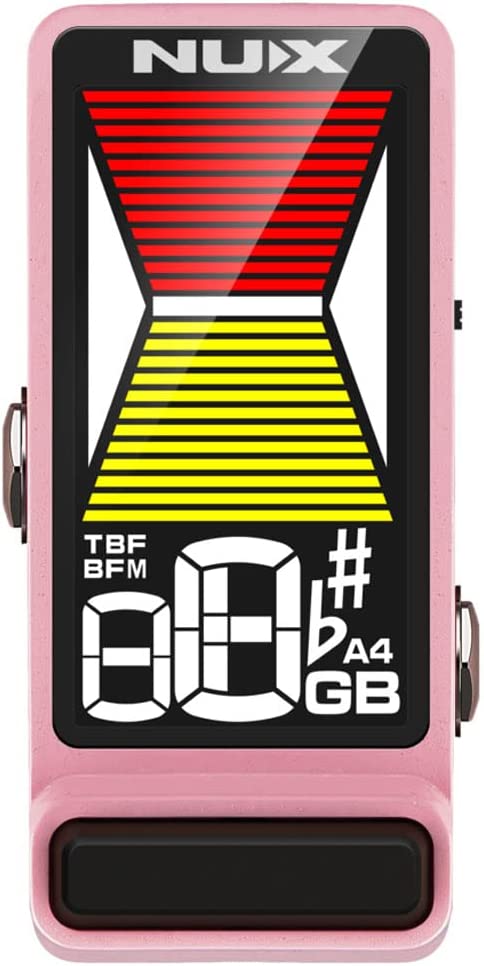
The NUX NTU-3 Pedal Tuner Flow Tune for Chromatic, Guitar, Bass is a compact tuner designed for live performances.
Its high-definition LCD is easy to read in any lighting condition.
It has three display modes, including a Strobo mode and two Arrow modes, which create a visual display that resembles a flowing river.
The pedal tuner features three modes: True Bypass, Buffered Bypass, and Buffered Bypass Monitor, allowing users to switch between them according to their preferences and the environment.
The BUFFER mode boosts the signal over long cables to avoid loss of tone, keeping it clean and clear.
The BUFFER MONITOR mode allows users to check all notes played without stopping playing and bending.
The specially-designed footswitch provides comfortable pressing feedback, and the pedal’s compact size and steady weight make it easy to fit on a pedalboard with velcro.
- My Review
After testing the NUX NTU-3 Pedal Tuner Flow Tune for Chromatic, Guitar, Bass, I have to say that it is a solid tuner pedal that is great for live performances.
The high-definition LCD is large and easy to read, making tuning on stage a breeze.
In addition, the three display modes, including the Strobo mode and two Arrow modes, create a flowing river-like display that is visually pleasing and easy to follow.
One of the standout features of this pedal tuner is its True Bypass, Buffered Bypass, and Buffered Bypass Monitor modes.
The BUFFER mode is especially useful for electric guitars that use passive pickups with a high-impedance output.
It boosts the signal over long cables, ensuring that there is no loss of tone.
The BUFFER MONITOR mode is also great for checking notes while playing without stopping or bending, making it convenient for live performances.
The pedal tuner’s compact size and steady weight make it easy to fit on a pedalboard with velcro.
In addition, the specially-designed footswitch provides comfortable pressing feedback, which is great for extended periods of use.
One thing to note is that there aren’t any negative reviews of the product yet.
Here are the ratings I’ll give to the NUX NTU-3 Tuner Pedal:
However, I did notice that the pedal tuner’s enclosure is made of plastic, which could be a concern for some users who prefer sturdier materials.
It’s also worth mentioning that while the pedal tuner is designed for guitar and bass, it can also be used for other instruments, such as a ukulele.
- Pros:
- Large, high-definition LCD display
- 3 display modes, including Strobo mode
- Offers True Bypass and Buffered Bypass modes
- Compact size and steady weight
- Cons:
- No negative reviews available
My final verdict is that the NUX NTU-3 Pedal Tuner Flow Tune for Chromatic, Guitar and Bass is a versatile and feature-rich tuner pedal that can be a valuable addition to a musician’s gear.
Its large high-definition LCD and different modes make it easy to read and use in different environments.
The True Bypass, Buffered Bypass, and Buffered Bypass Monitor modes provide different performance settings and cable lengths options.
In addition, the NUX brand is renowned for producing affordable and quality music gear, which could give musicians confidence in the product.
Overall, the NUX NTU-3 Pedal Tuner Flow Tune offers good value for money and could be useful for musicians looking for an accurate and reliable tuner pedal.
Korg Pitchblack Mini Tuner Pedal
Vibrant color, ultra-accurate tuning, and mini-size design.
The Pitchblack Mini tuner is now available in three fashion-forward colors, allowing you to liven up your setup with vivid green, orange, and purple models. The reliable tuning and slim space-saving design remain the same.
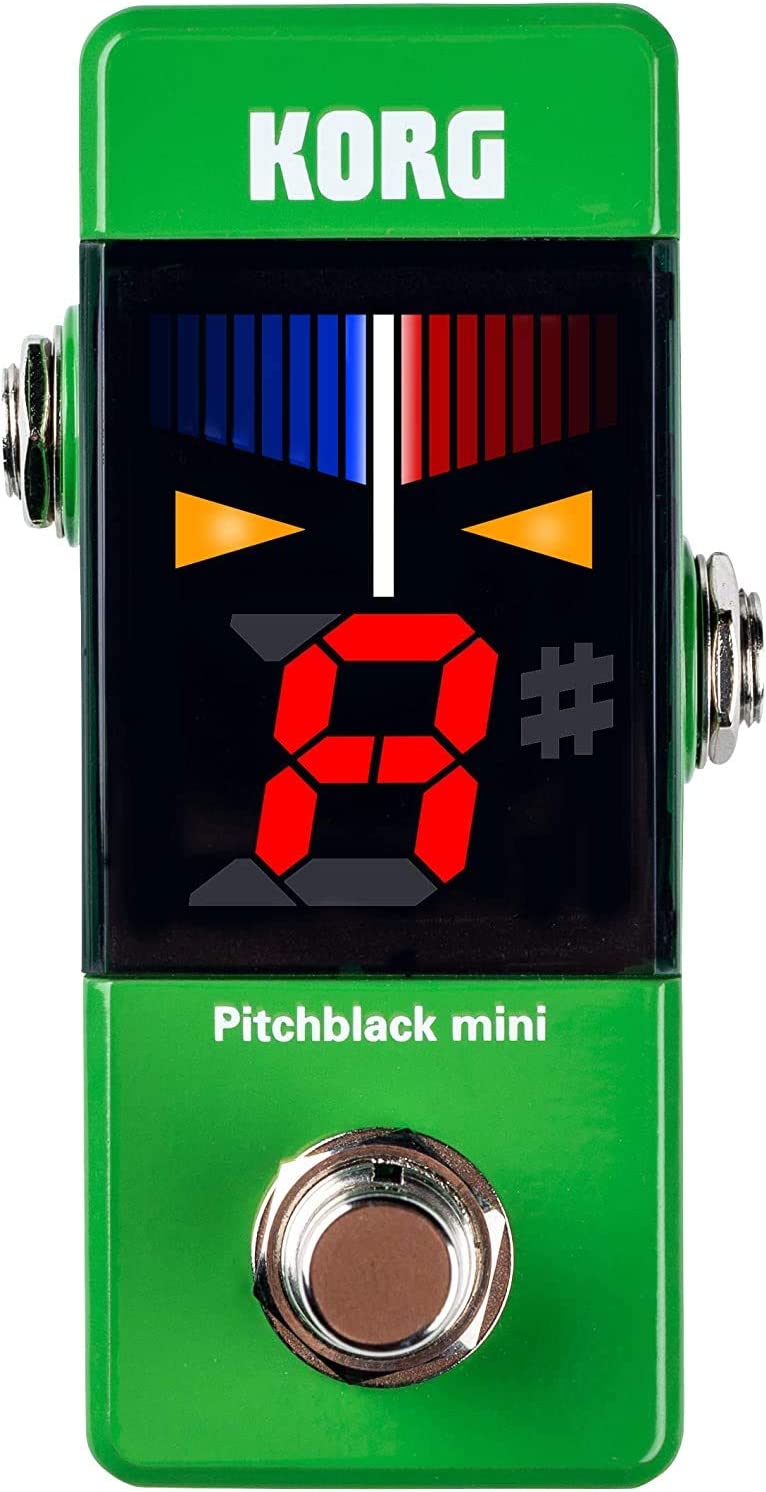
The Korg Pitchblack Mini Pedal Tuner is a high-precision tuning device designed for guitarists needing accurate pedalboard tuning.
This compact tuner is small enough to fit tight spaces on a pedalboard and has a bright, easy-to-read display showing the note name and tuning status.
In addition, the tuner offers three-meter display modes, including a strobe mode, which makes it easy to see when you’re in tune.
The Pitchblack Mini Pedal Tuner also supports battery operation, which means you can use it on the go without worrying about finding an outlet.
One of the most useful features of the Korg Pitchblack Mini Pedal Tuner is its ultra-high tuning accuracy of +/- 0.1 cents.
This level of accuracy is particularly important for guitarists who want to ensure their instrument is in tune with itself and other instruments they may be playing with.
The adjustable calibration and stabilizers also help prevent overturning, ensuring that your tuning remains accurate even during intense performances.
- My Review
As a product reviewer, I had the opportunity to test out the Korg Pitchblack Mini Pedal Tuner, and overall, I am very impressed with its performance and features.
One of the standout features of this tuner is its compact size, which makes it easy to fit onto a crowded pedalboard.
Despite its small size, the display is bright and easy to read, clearly showing the note name and tuning status.
In addition, the three-meter display modes, including a strobe mode, make it easy to see when you’re in tune, even in low-light conditions.
Another impressive feature of the Pitchblack Mini Pedal Tuner is its ultra-high tuning accuracy of +/- 0.1 cents.
This level of accuracy ensures that your guitar is in tune with itself and other instruments, which is crucial for playing in an ensemble or recording in a studio.
The adjustable calibration and stabilizers are also very helpful in ensuring that the tuner remains accurate and stable, even during intense performances.
The true bypass feature is another aspect of this tuner that I appreciate.
It ensures no signal degradation or tone loss when the tuner is not in use, which is important for maintaining the integrity of your guitar’s sound.
In terms of value, I think the Korg Pitchblack Mini Pedal Tuner is priced reasonably for its high level of accuracy and range of features.
However, some users may find it a bit more expensive than other tuners on the market.
Here are the ratings I’ll give to the Korg Pitchblack Mini Tuner Pedal:
One minor issue I encountered during testing is that the battery life of the tuner is not as long as I would have liked.
While it is nice to have the option of battery operation, it would be helpful if the battery lasted longer between replacements.
- Pros:
- High-visibility display with 3 modes.
- Battery operation supported.
- Adjustable calibration and stabilizers.
- Ultra-high tuning accuracy (+/- 0.1 cents).
- True bypass to preserve tone.
- Cons:
- No major cons found.
My final verdict is that the Korg Pitchblack Mini Pedal Tuner – Green (an Austin Bazaar Exclusive) is a high-quality and reliable product with exceptional tuning accuracy and a range of convenient features.
With its mini-size design, battery operation, adjustable calibration, and true bypass, this tuner is perfect for guitarists looking for a space-saving solution that does not compromise performance or tone.
Additionally, the product’s availability in three new colors adds a touch of style to your setup.
Overall, I would highly recommend the Korg Pitchblack Mini Pedal Tuner to any guitarist looking for a top-quality tuner for their pedalboard.
What exactly is a tuner pedal?
A tuner pedal, also known as a guitar tuner or chromatic tuner pedal, is an electronic device designed to aid musicians in accurately tuning their instruments, most commonly guitars and bass guitars.
This compact, stompbox-style device is a critical component of a musician’s pedalboard and is usually placed first in the signal chain to ensure the most accurate tuning possible.
The tuner pedal works by analyzing the pitch of a note played on the instrument, comparing it to a reference frequency, and then displaying the difference on a screen or LED display, allowing the musician to adjust accordingly.

The history of the tuner pedal dates back to the 1970s when guitar effects pedals began gaining popularity among musicians.
Before the advent of electronic tuners, musicians relied on tuning forks, pitch pipes, or their ears to tune their instruments.
However, as rock music evolved, the need for accurate tuning became more apparent.
This was especially true for guitarists who relied on various alternative tunings and complex chord voicings to create their signature sounds.
The first electronic guitar tuners were large, bulky devices that were not portable or easy to use on stage.
Then, in the early 1980s, the first compact, pedal-based tuners appeared on the market.
The Boss TU-12, released in 1983, was one of the earliest examples of a tuner pedal.
This device used an analog needle-style display to show the musician how far off their tuning was from the desired pitch.
The TU-12 was a game-changer for musicians, allowing them to quickly and accurately tune their instruments in any environment.
As technology advanced, tuner pedals became more accurate and easier to use.
LED displays replaced analog needles, making it easier for musicians to see their tuning status even in low-light situations.
In 1998, the Boss TU-2 Chromatic Tuner was released, quickly becoming a standard piece of equipment for many professional guitarists.
The TU-2 featured a bright LED display and a robust, stage-ready design.
It also introduced a new chromatic tuning mode, which allowed musicians to tune their instruments to any note, not just standard guitar tuning.
In the following years, many other manufacturers began developing their tuner pedals, each with unique features and innovations.
Korg, for instance, released the Pitchblack series, which was notable for its large, easy-to-read display and true bypass circuitry.
In addition, TC Electronic’s PolyTune series, launched in 2010, made history as the first polyphonic tuner pedal, allowing guitarists to tune all six strings simultaneously.
Today, tuner pedals come in various shapes, sizes, and price points, with features catering to the specific needs of different musicians.
For example, many modern tuner pedals offer multiple tuning modes, such as chromatic, strobe, and polyphonic, as well as alternate tuning presets for various styles of music.
Some models also provide features like metronomes, pitch calibration, and built-in buffers to enhance a guitar’s signal chain.
What should you consider when choosing a tuner pedal?
When choosing a tuner pedal for your guitar or bass, several factors must be considered.
The right tuner pedal can significantly improve your tuning accuracy and enhance your overall playing experience.
We will explore key factors to consider when selecting a tuner pedal, including sound quality, controls, features, analog vs. digital, build quality and durability, presets and versatility, brand reputation, price and price, and budget, and reviews and recommendations.
– Sound quality:
The sound quality of a tuner pedal is one of the most important factors to consider when making a decision.
Look for a pedal with accurate pitch detection and a clear, easy-to-read display to ensure you can quickly and efficiently tune your instrument.
In addition, aIn addition, a high-quality tuner pedal will provide precise tuning and help you maintain the intonation of your guitar or bass.
– Controls and features:
When evaluating tuner pedals, it’s essential to consider the controls and features they offer.
Some tuners have a single button for tuning, while others provide more advanced controls, such as pitch calibration, drop tuning, and alternate tunings.
Look for a tuner pedal that lets you quickly switch between standard and alternate tunings or adjust the pitch reference if needed.
Additional features include a bypass function, which allows you to tune your instrument without affecting your signal chain, and a mute function, which enables silent tuning on stage.
A chromatic tuner that detects all 12 notes in the scale can benefit musicians who play in multiple keys or use alternative tunings.
– Analog vs.Digital:
When selecting a tuner pedal, you may have to choose between analog and digital options.
Analog tuners use mechanical components to detect pitch, while digital tuners use microprocessors and software algorithms.
Digital tuners are generally more accurate, faster, and feature-rich than their analog counterparts.
However, analog tuners can provide a warmer, more natural sound that some musicians prefer.
Consider your personal preferences and the type of music you play when deciding between an analog or digital tuner pedal.
– Build quality and durability:
A durable tuner pedal is crucial for musicians who gig regularly or plan to use the pedal frequently.
Look for a tuner with sturdy metal or hard plastic housing that can withstand the rigors of live performances and repeated use.
High-quality components like switches and jacks will ensure the pedal lasts for years.
Additionally, a well-built pedal will resist interference and noise more, providing a more stable and reliable tuning experience.
– Presets and versatility:
The versatility of a tuner pedal can significantly impact its usability and value.
Some tuner pedals offer multiple tuning presets, allowing you to quickly switch between different tuning modes for various instruments or playing styles.
This can be particularly useful for musicians who play multiple instruments or use alternative tunings.
A versatile tuner pedal can save time and effort when switching between guitars or tunings during live performances or recording sessions.
– Brand reputation:
When selecting a tuner pedal, it’s essential to consider the brand’s reputation.
Brands with a history of producing high-quality, reliable pedals will likely provide a better product.
Research the top brands in the tuner pedal market, such as Boss, TC Electronic, Korg, and Peterson, and consider their offerings based on your needs and preferences.
In addition, a reputable brand is more likely to offer a good warranty and customer support, providing peace of mind in case of any issues with your pedal.
– Price and budget:
The cost of a tuner pedal can vary significantly, from budget options under $50 to high-end models costing several hundred dollars.
When setting a budget, consider the features and performance you require and how much you will spend to achieve those goals.
Investing in a high-quality tuner pedal can save you money in the long run, as it will likely be more durable and provide better performance than cheaper alternatives.
While it’s essential to stay within your budget, don’t sacrifice quality or necessary features to save a few dollars.
– Reviews and recommendations:
Before making a final decision, consult reviews and recommendations from fellow musicians, online forums, and music publications.
These sources can provide valuable insights into the real-world performance of a tuner pedal and highlight any potential issues or shortcomings.
Check reviews that discuss the factors mentioned earlier, such as sound quality, build quality, and versatility, as these will be most relevant to your decision-making process.
How to properly use a tuner pedal?
Tuner pedals are essential for musicians, particularly guitarists and bassists, as they ensure their instruments are in tune before and during performances.
A well-tuned instrument enhances the band’s overall sound and improves the playing experience for the musician.
This guide will walk you through the proper use of a tuner pedal in four steps.
– Familiarize yourself with the controls and features:
Before using a tuner pedal, it’s crucial to understand its controls and features.
While the specifics may vary depending on the brand and model, most tuner pedals share some common elements:
- Input jack: This is where you plug in your instrument cable.
- Output jack: Connect this to your amplifier or the next pedal in your signal chain.
- Bypass footswitch: This allows you to engage or disengage the tuner without unplugging your instrument. When disengaged, the pedal will not affect your signal.
- Display: This shows the current pitch of your instrument and how far it is from the target pitch. Displays may be LED, LCD, or a combination of both.
- Calibration button/switch: This allows you to set the reference pitch (usually A440 Hz) to which the tuner will tune your instrument.
- Tuning mode selector: Some tuners offer different tuning modes, such as chromatic, guitar, bass, or drop tuning.
- Flat/sharp indicator: This shows whether your instrument is flat (too low) or sharp (too high) in pitch.
- Mute/tuning mode footswitch: This allows you to mute your signal while tuning or switch between tuning modes.
Some tuners may also include additional features, such as a metronome, a built-in DI box, or the ability to tune multiple instruments simultaneously.
My point is, understanding the controls and features of your tuner pedal is essential for achieving accurate and precise tuning.
So I’d say, take the time to familiarize yourself with your specific tuner and its capabilities to get the most out of it.
– Adjust the parameters to suit your musical goals:
When you become familiar with the controls of your tuner, it is essential to adjust the parameters to achieve the best results for your musical goals.
Start by setting the reference pitch according to your specific musical requirements.
This could be the standard A440 tuning, or you may need to use a different reference pitch for certain musical styles or collaborations.
If playing with other people, it’s crucial that all musicians in your ensemble/band are using the same reference pitch to ensure a cohesive sound.
Next, carefully select the appropriate tuning mode for your instrument.
Chromatic mode is highly versatile, allowing you to tune any instrument, including those with non-standard tunings or alternative scales.
However, if you’re playing a guitar or bass, you might prefer using the dedicated guitar or bass modes, which cater specifically to the tuning needs of those instruments and provide a more streamlined tuning experience.
Some tuner pedals come with adjustable display brightness, which can be a helpful feature for different performance environments.
– Incorporate the tuner pedal into your signal chain:
The next step is to integrate the tuner pedal into your signal chain.
The most common placement for a tuner pedal is at the beginning of the chain, right after your instrument.
This ensures the tuner receives your guitar or bass’s cleanest, unprocessed signal, then after that, connect your instrument to the input jack of the tuner pedal using an instrument cable.
You can then connect the tuner pedal’s output jack to the next pedal’s input in your chain or directly to your amplifier.
Press the bypass footswitch to turn on your amplifier and engage the tuner pedal; at the same time ensure your instrument is plugged in and the tuner pedal is engaged before tuning.
How to order pedals on a pedalboard?
There is no one-size-fits-all approach to ordering pedals on a pedalboard, as the optimal arrangement largely depends on the specific sound you’re aiming for.
Usually, though, you will see guitar players mostly agreeing with this order:
Tuner > Filters/Dynamics > Pitch-based Effects > Overdrive/Distortion > Modulation > Time-based Effects > Looper
Aside from that, some general guidelines can help you achieve a balanced and versatile setup.
Let’s talk in detail about the order we just mentioned, but feel free to experiment and adjust to your own preferences:
- Tuner: Place your tuner pedal first to ensure your signal is in tune before passing through the other pedals.
- Filters and dynamics: Wah-wah, envelope filters, compressors, EQs, and noise gates should come next. These pedals affect your sound’s dynamic and tonal aspects, so it’s best to place them early in the chain.
- Pitch-based effects: Octavers, harmonizers, and pitch shifters should come after filters and dynamics since these pedals alter the pitch of your signal and work best with a clean, unprocessed sound.
- Overdrive and distortion: Overdrive, distortion, and fuzz pedals typically come next. They shape your guitar’s core sound, and placing them before most other effects ensures that those effects receive a strong, consistent signal.
- Modulation effects: Chorus, flanger, phaser, and tremolo pedals should be placed after overdrive and distortion effects. We do this to allow these pedals to add depth and movement to your sound without becoming overly distorted or overbearing.
- Time-based effects: Delay and reverb pedals should be placed towards the end of your signal chain. This allows them to create a sense of space and depth around the other effects, simulating the sound of a room or hall.
- Looper: If you use a looper pedal, it should be placed last in the chain. This ensures that you’re looping the entire signal, including all the effects you’ve applied.
Remember, these are just general guidelines and what generally works and sounds good.
The most important thing is to experiment and find the arrangement that best suits your personal sound and style.
For example, here’s one pedalboard signal chain that I always use:
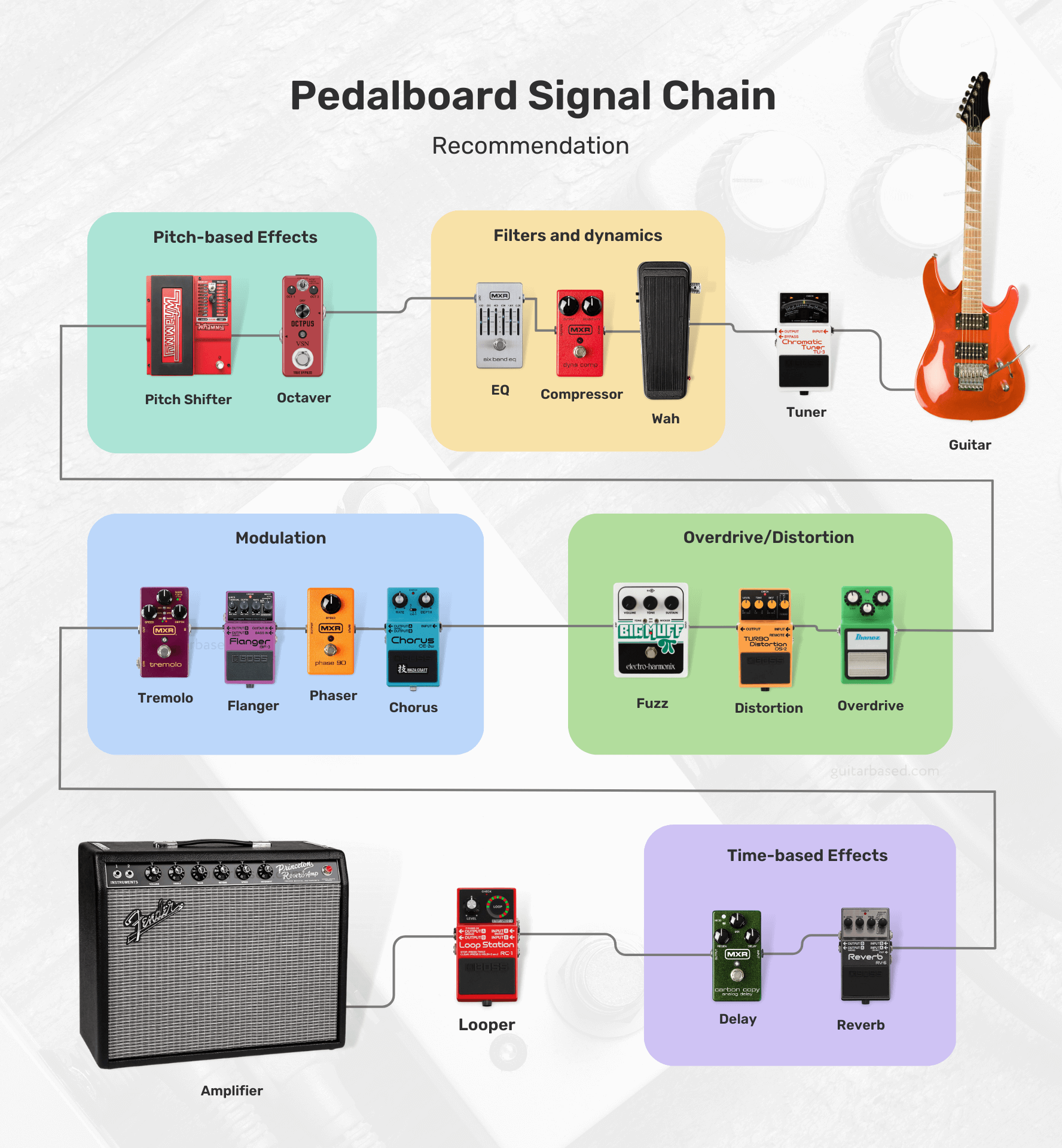
Feel free to swap the order of pedals, try different combinations, and test out unconventional setups until you find the one that works best for you.
For those interested, I’ll leave you with most of the possibilities that you’ll encounter and how to order them.
- Tuner
- Filters/Dynamics:
- Volume
- Wah
- Auto-Wah
- Compressor
- Noise Gate
- EQ (Equalizer)
- Pitch-based Effects:
- Octaver
- Harmonizer
- Pitch Shifter
- Overdrive/Distortion/Fuzz:
- Boost
- Overdrive
- Distortion
- Fuzz
- Modulation:
- Chorus
- Phaser
- Flanger
- Univibe
- Vibrato
- Tremolo
- Time-based Effects:
- Delay
- Echo
- Reverb
- Synth/Bitcrusher:
- Synth
- Bitcrusher
- Acoustic Simulator
- Multi-Effects
- Utility:
- Buffer
- A/B/Y Switcher
- MIDI Controllers
- Looper
Boutique vs. Mass-Produced pedals
Boutique pedals are generally built with higher-quality components and craftsmanship, resulting in better durability and longevity.
These pedals often feature unique and innovative designs, providing a wider range of tones and effects that may not be available in mass-produced options.
Here are a few examples of boutique pedals:

All the manufacturers also tend to have a more personal approach, with better customer service and the ability to customize pedals according to the user’s preferences.
However, boutique pedals are usually more expensive due to the smaller scale of production and the use of premium components.
Mass-produced pedals, on the other hand, are more affordable due to their larger scale of production and the use of cost-effective components.
These pedals are widely available and offer a range of popular effects, making them accessible to a larger audience.
Here are a few examples of mass-produced pedals:

The quality control for mass-produced pedals can vary depending on the brand and model, but many are reliable and offer good value for the money.
As for one of the downsides, you’ll find that mass-produced pedals may not have the same level of uniqueness or innovation as boutique options.
On the other hand, they may not provide the same level of customer service or customization options.
The choice between boutique and mass-produced pedals depends on your personal preferences, budget, and desired sound.
If you’re looking for unique tones, higher-quality components, and a more personal experience, boutique pedals may be the way to go.
But I would say, for those who are on a budget and need access to popular effects, mass-produced pedals might be a better fit.
It’s worth trying out both types to see which best suits your needs and playing style.
How much should you spend on a guitar pedal?
If I were in your position, I would first determine my budget and specific needs before deciding how much to spend on a guitar pedal.
For beginners, it might be more reasonable to start with affordable, mass-produced pedals to explore different effects without spending too much.
Guitar pedals can range in price from around $30 to over $400, depending on the brand, quality, and complexity of the effect.
As your skills and understanding of your preferred tone develop, you can gradually upgrade to higher-quality or boutique pedals.
One thing I would do is consider which effects are essential to your playing style and prioritize purchasing those first.
Allocating a larger portion of your budget to the most important pedals might be a wise choice, especially if you only need a few basic effects.
However, if you require a wide array of effects, you may want to consider more budget-friendly options or multi-effects units.
Keep in mind that higher-priced pedals often come with better build quality, unique features, and improved sound quality.
But I would also say that price is not always directly correlated with quality or suitability for your needs.
Sometimes, a more affordable pedal can deliver the exact sound you’re looking for, while a higher-priced option might not meet your expectations and are only expensive because of the brand reputation.
Can you use a guitar pedal with a bass guitar?
You can certainly use a guitar pedal with a bass guitar.
But it’s crucial to be aware that some guitar pedals may not be specifically designed to accommodate the frequency range of a bass guitar.
This could result in a less-than-ideal performance or an altered tone that might not be what you were expecting.
If you’re feeling adventurous and eager to experiment with your sound, don’t hesitate to connect your guitar pedals to your bass guitar.
This can be a fun way to explore different sonic possibilities, and you might even stumble upon some unique tones that complement your playing style perfectly.
Using a guitar pedal with a bass guitar may not always produce the desired results.
In some cases, the low-end frequencies might be lost, or the effect could sound too harsh or muddy.
To avoid these issues, you could consider looking into pedals that are specifically designed for bass guitars.
These pedals are engineered with the bass frequency range in mind, ensuring that your low-end remains intact and the effect sounds as intended.
In addition to bass-specific pedals, there are also multi-effects processors and pedals that cater to both guitar and bass players, offering a wide range of effects and tonal options.
These versatile units can be a great solution if you play both instruments and want a single device to cover your needs.
How to properly power your pedals?
When it comes to powering your pedals, you want to make sure you’re doing it right to avoid any noise issues or potential damage.
First, check each pedal’s power requirements, which you can usually find in the manual or on the pedal itself.
You’ll want to pay attention to the voltage (usually 9V, 12V, or 18V) and current (measured in milliamps or mA).
Now, you’ve got a few options for powering your pedals.
You can use individual power supplies or batteries for each pedal, but that can get messy and inconvenient.
I’d recommend going for a pedal power supply or an isolated power brick.

For example here are a few ones I recommend:
- Voodoo Lab Pedal Power 2 Plus Isolated Power Supply (My favorite)
- Rowin PW-1 Guitar Pedal Power Supply (Cheapest)
These babies can power multiple pedals at once, and the isolated outputs help prevent noise and ground loop issues.
Just make sure the power supply you choose can handle the voltage and current requirements of all your pedals.
When you’re connecting everything, use good quality power cables and keep them neat and tidy to avoid a tangled mess.
You might even want to use cable ties or cable organizers to keep everything in order.
In love with guitars, and gear; expert in all things music! Been writing about guitars for about 5 years and counting. Born in the ’90s. Alma Mater: University of Havana. Always curious, trying to understand the world. #TeamFender

